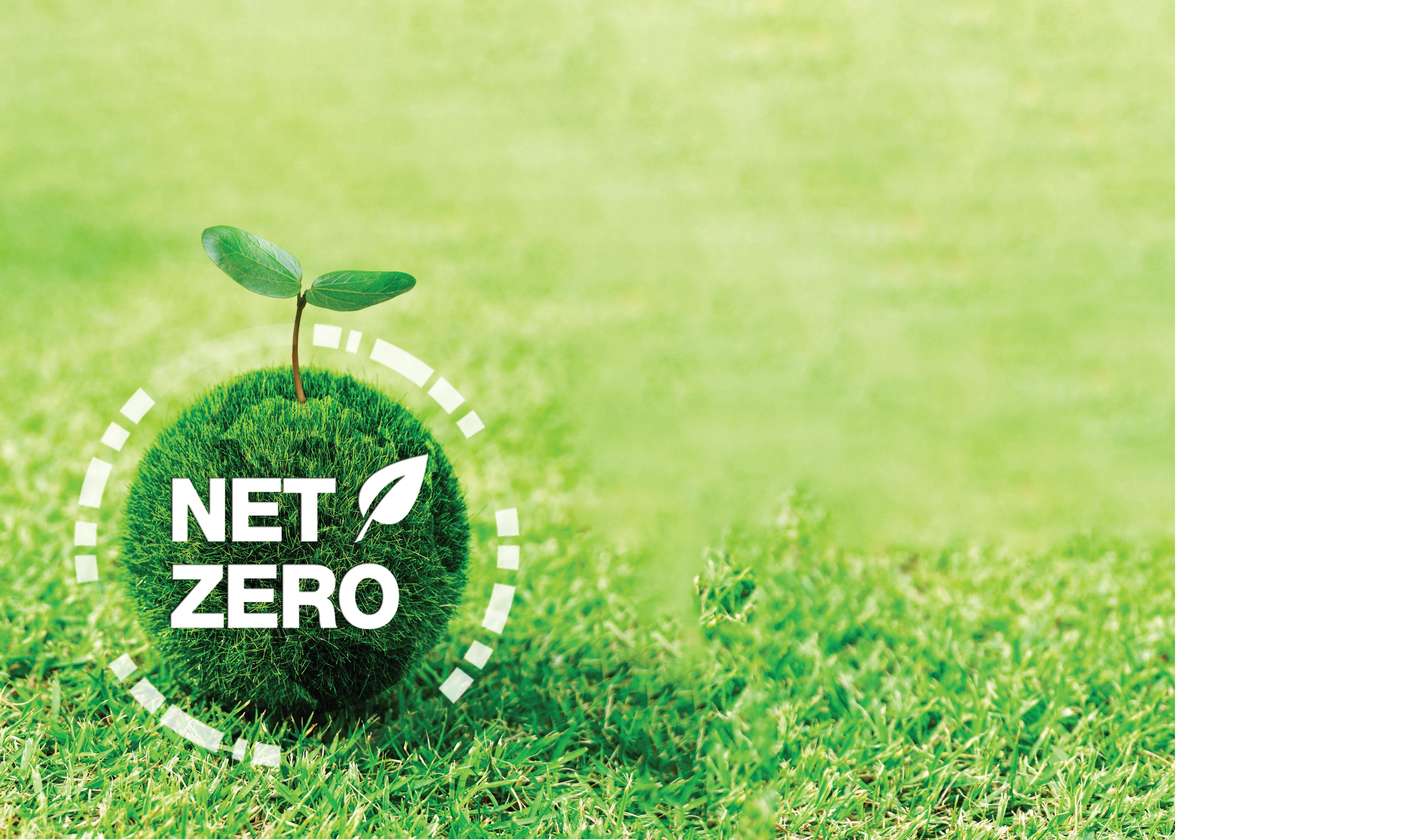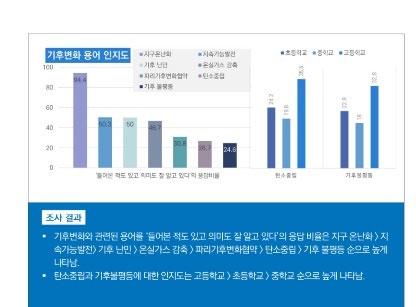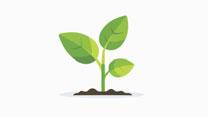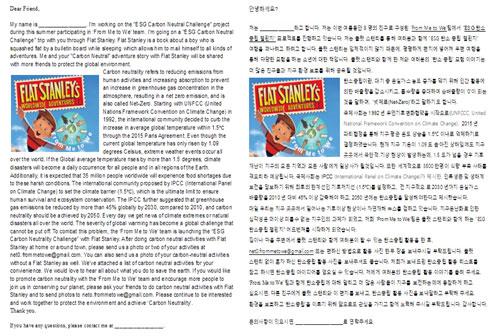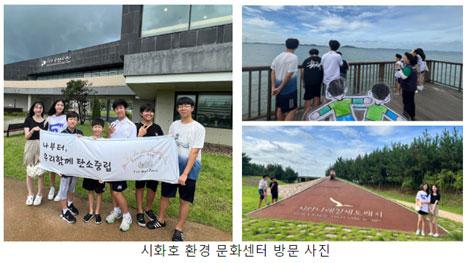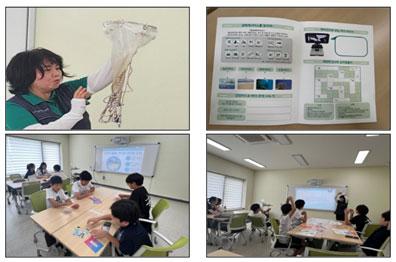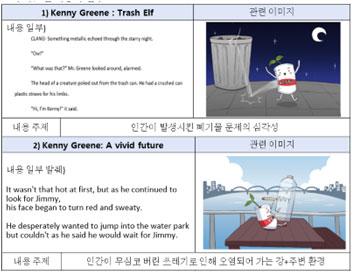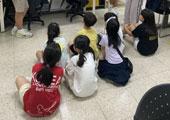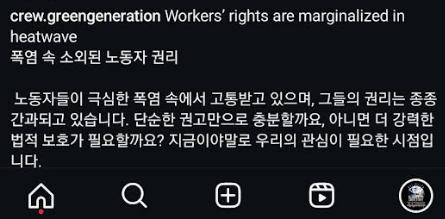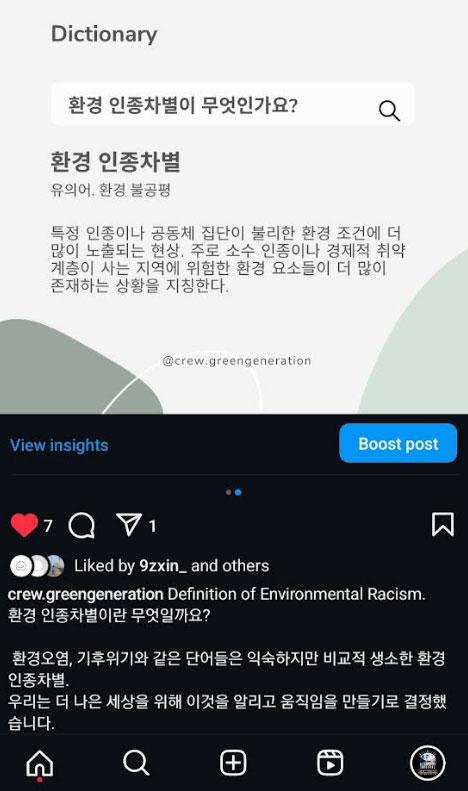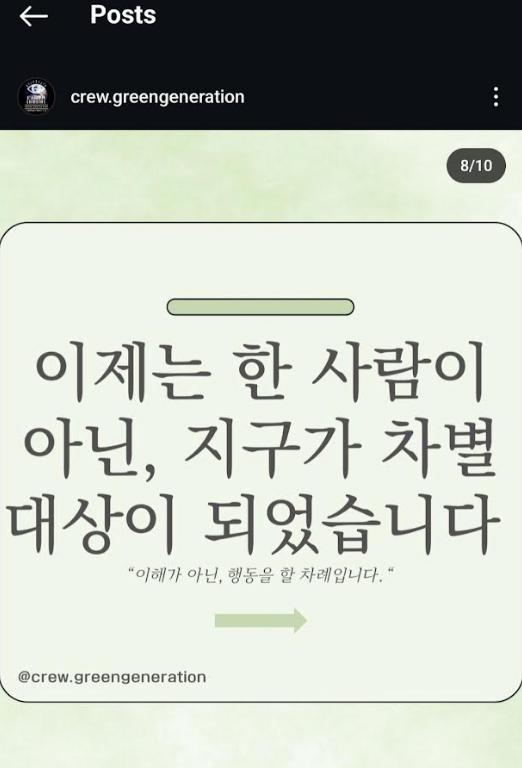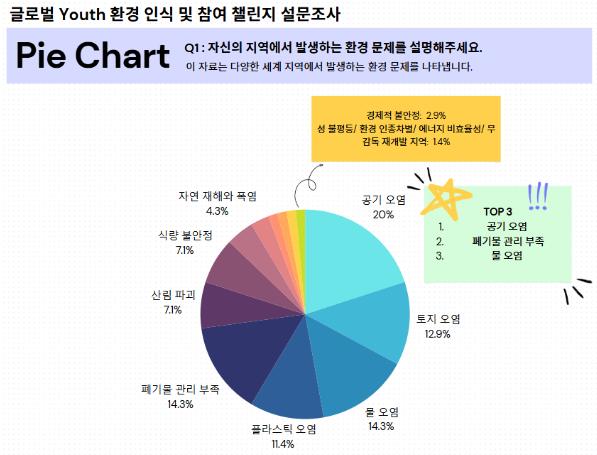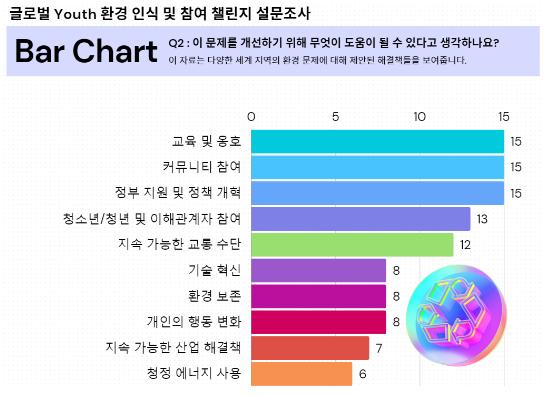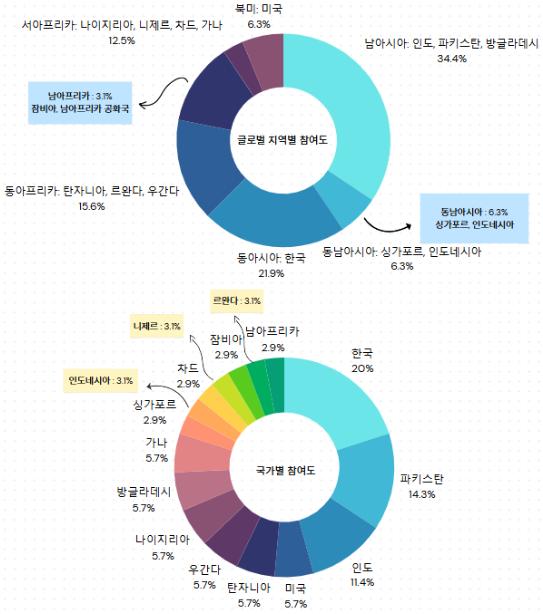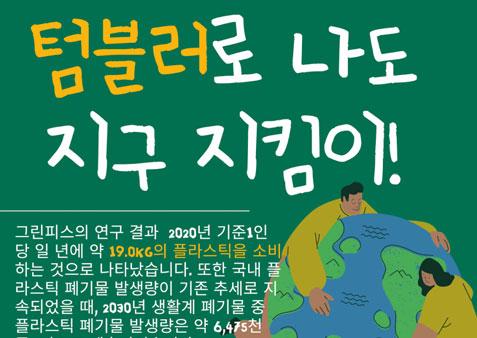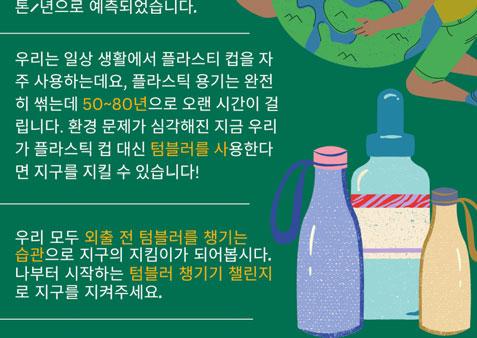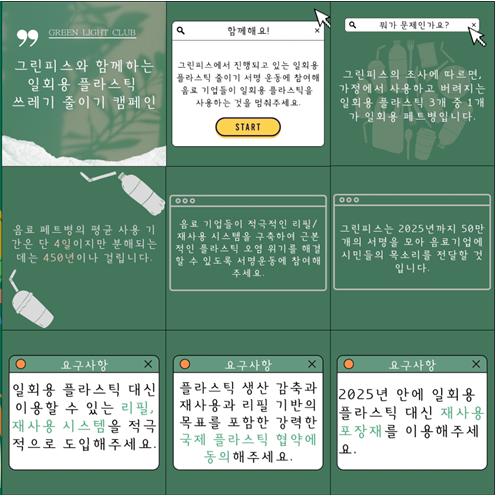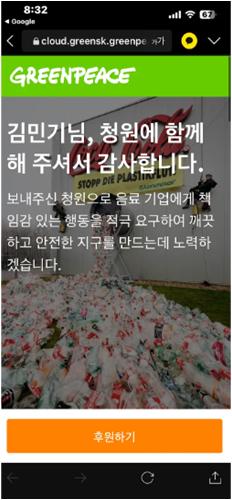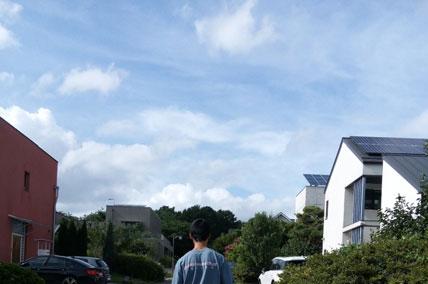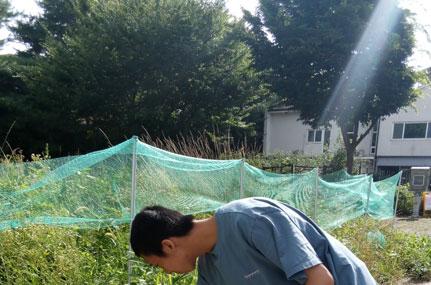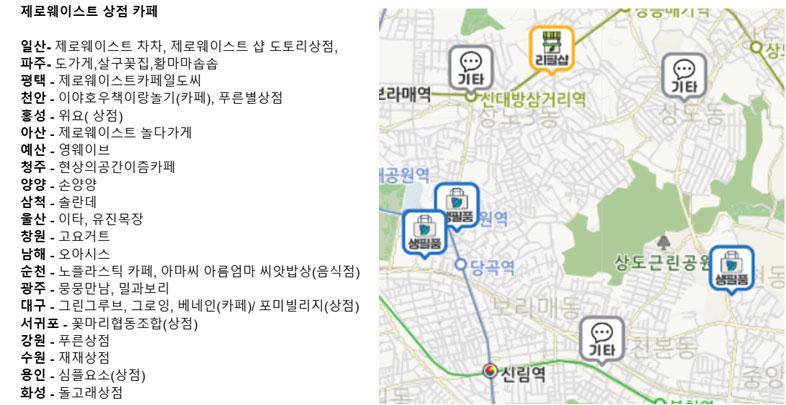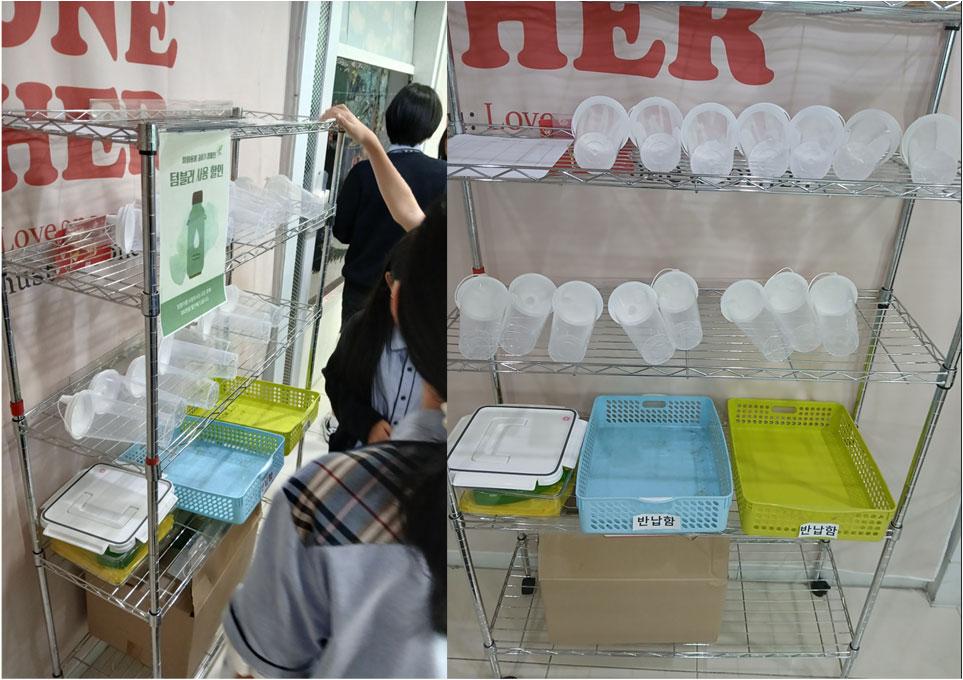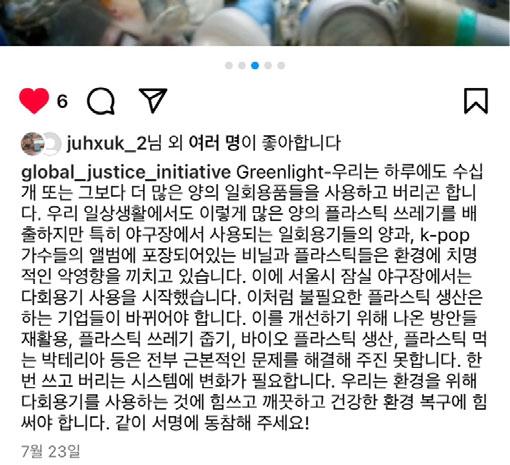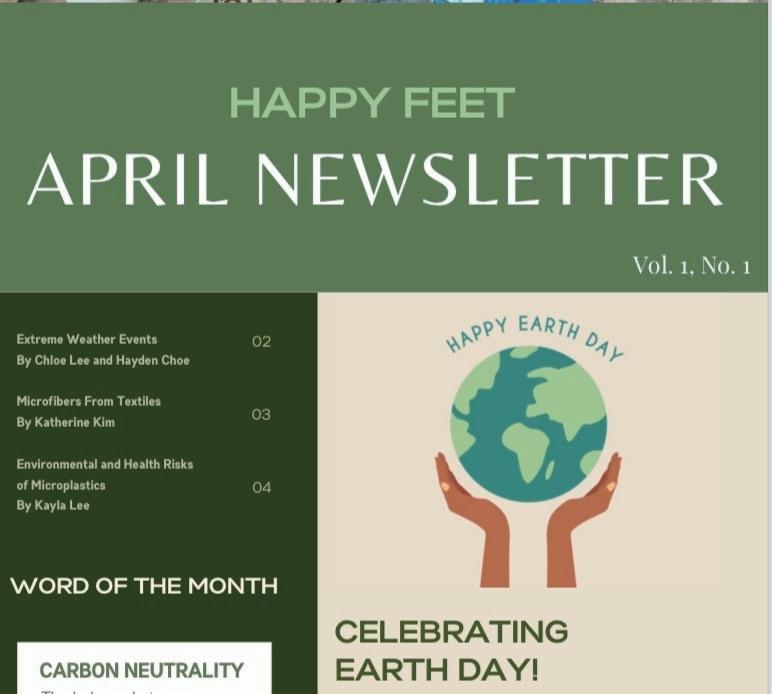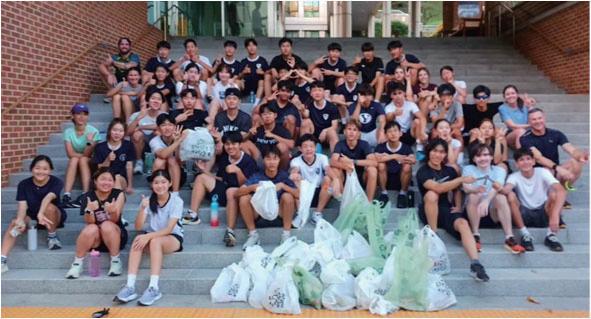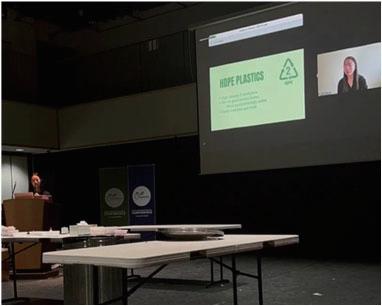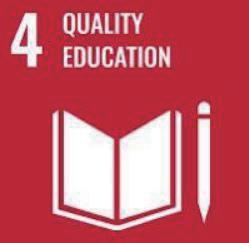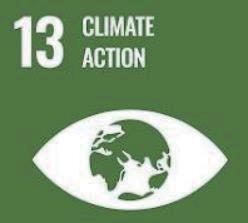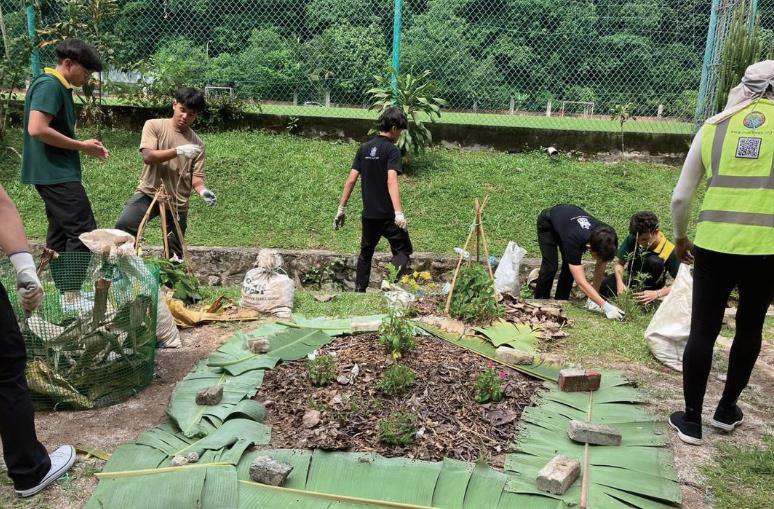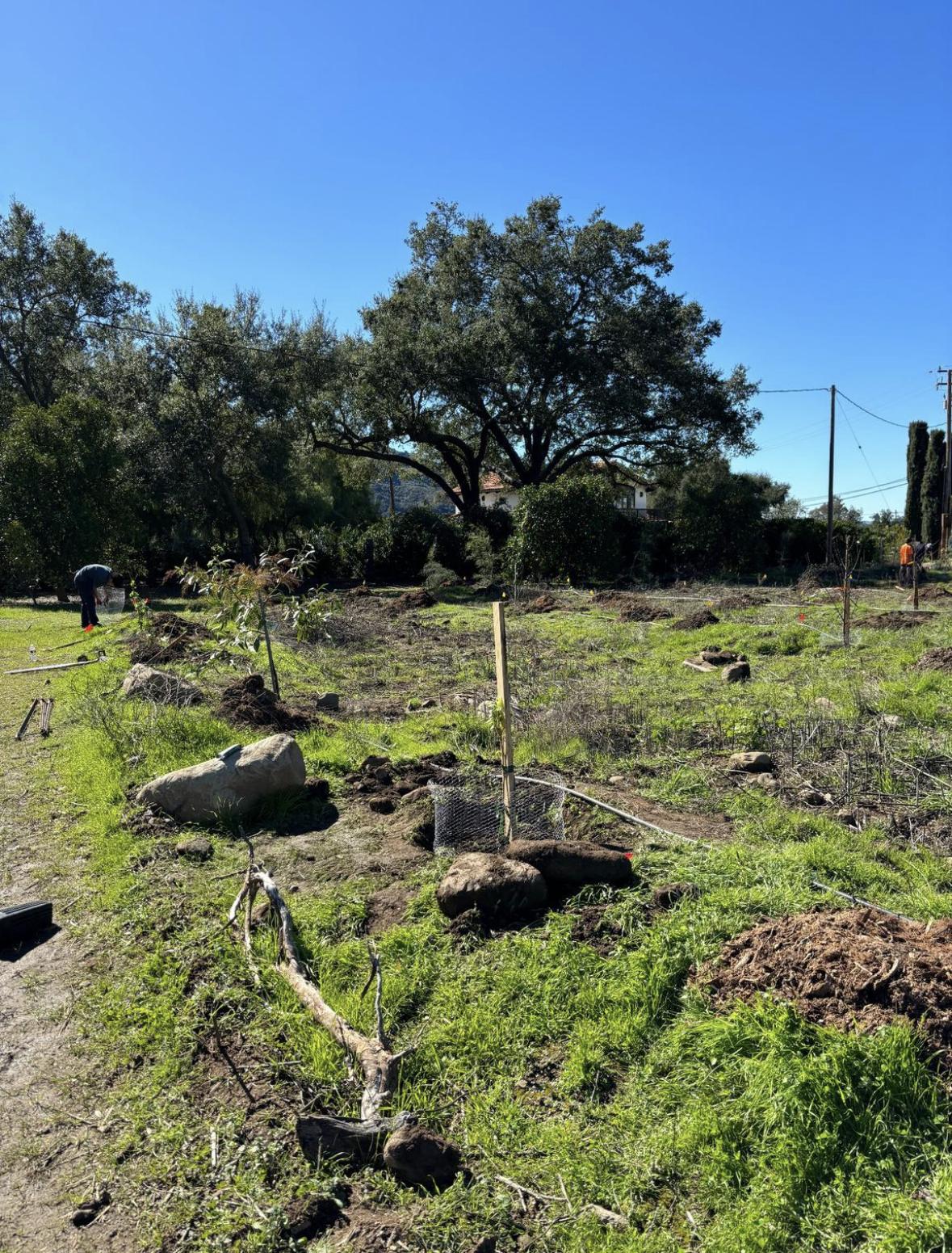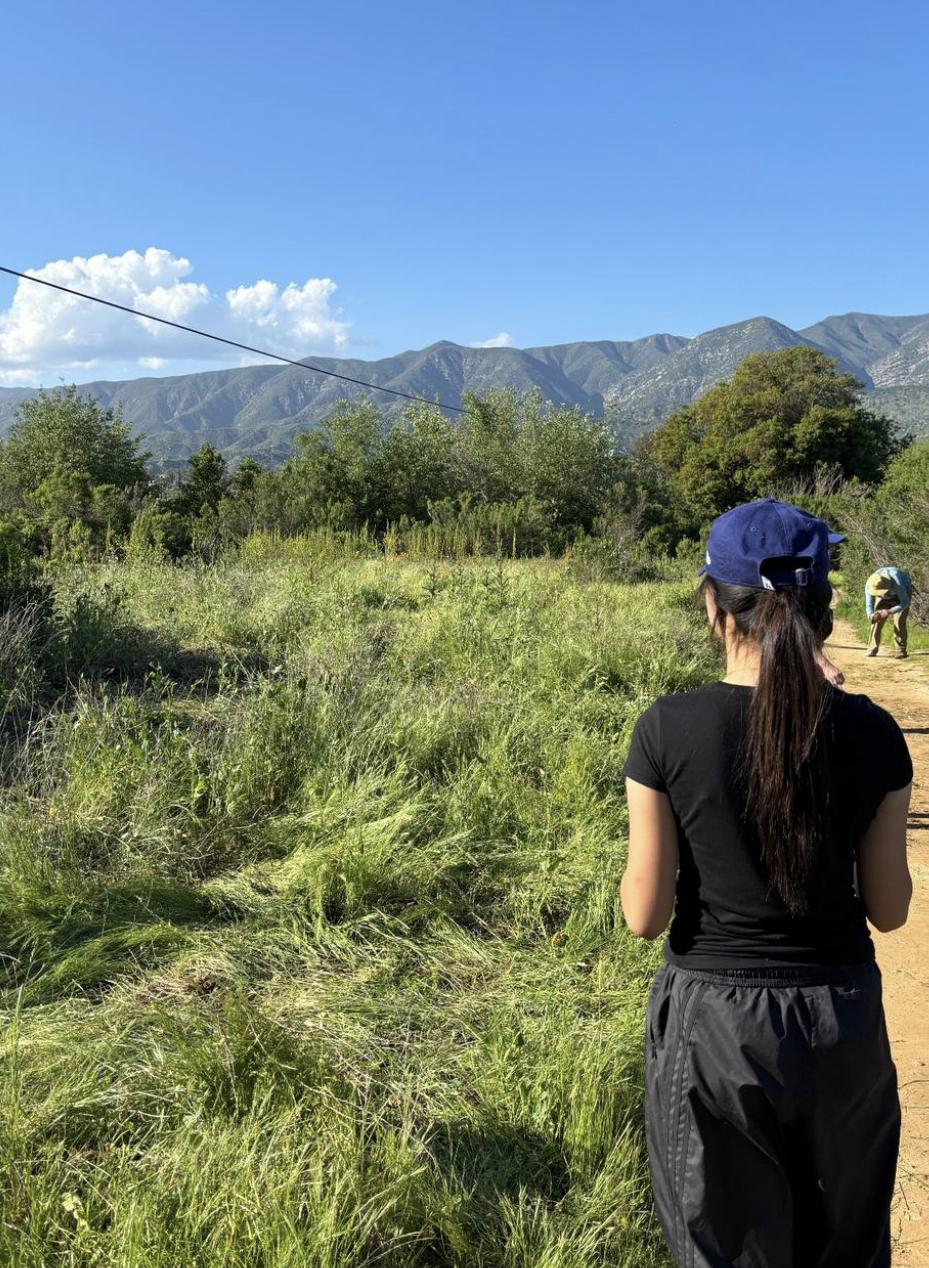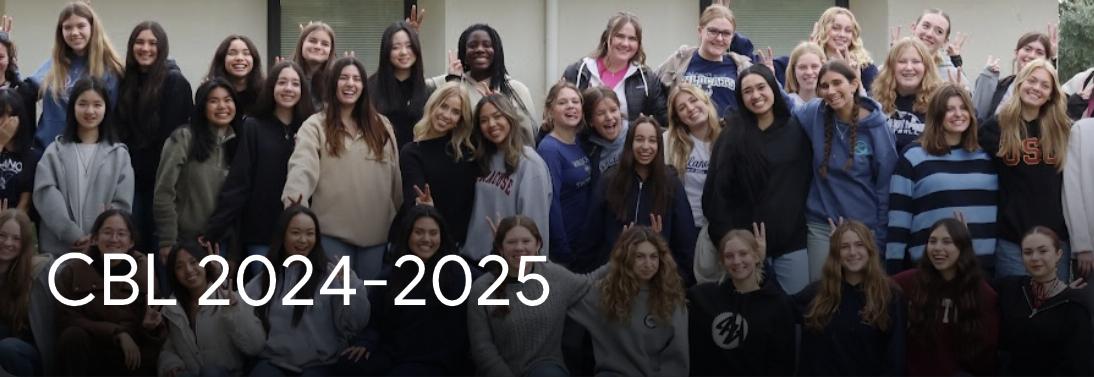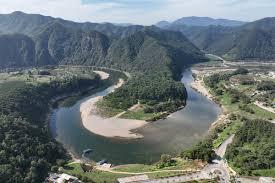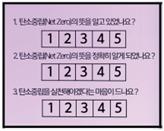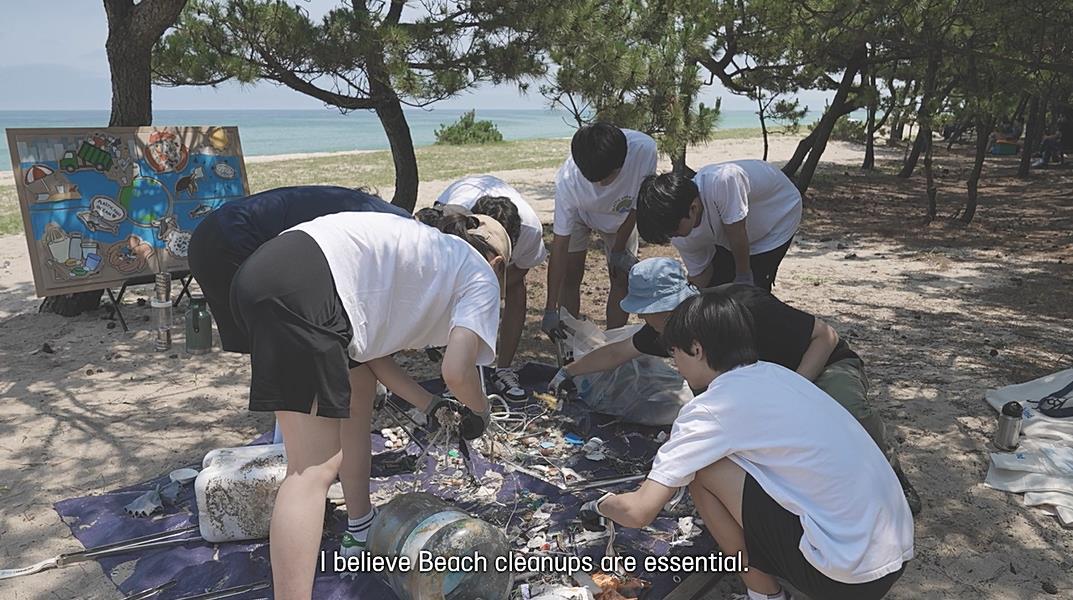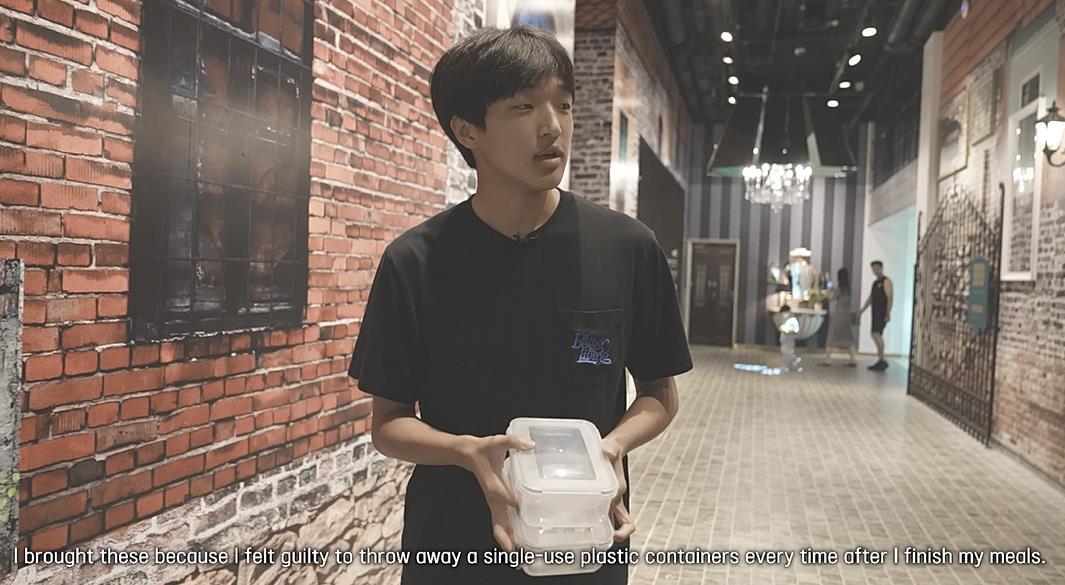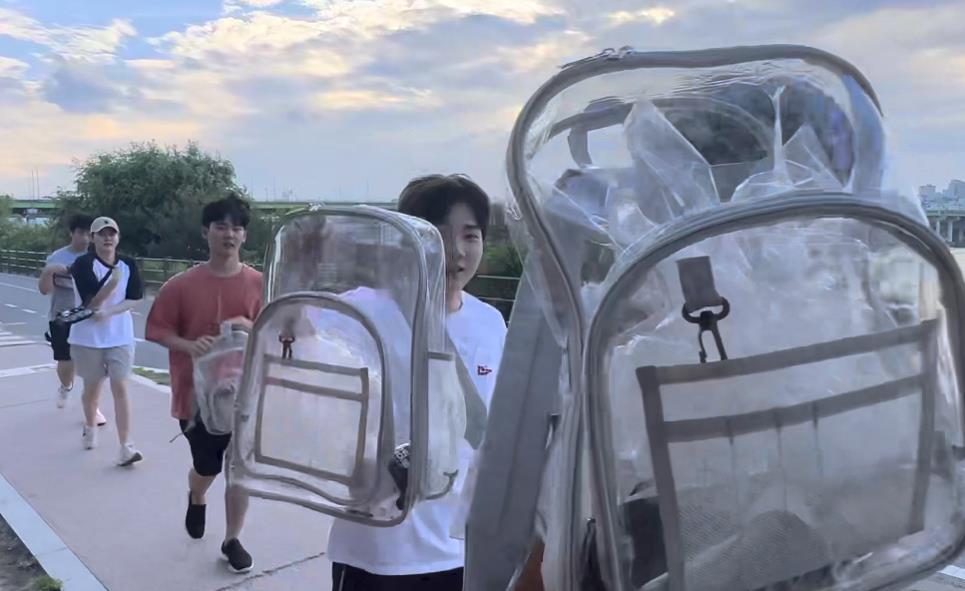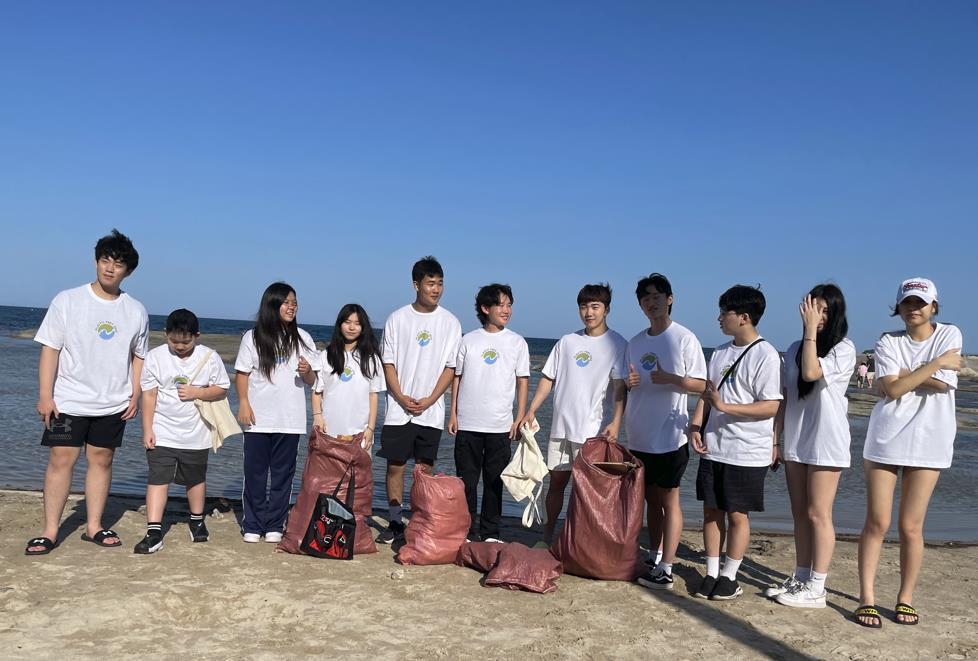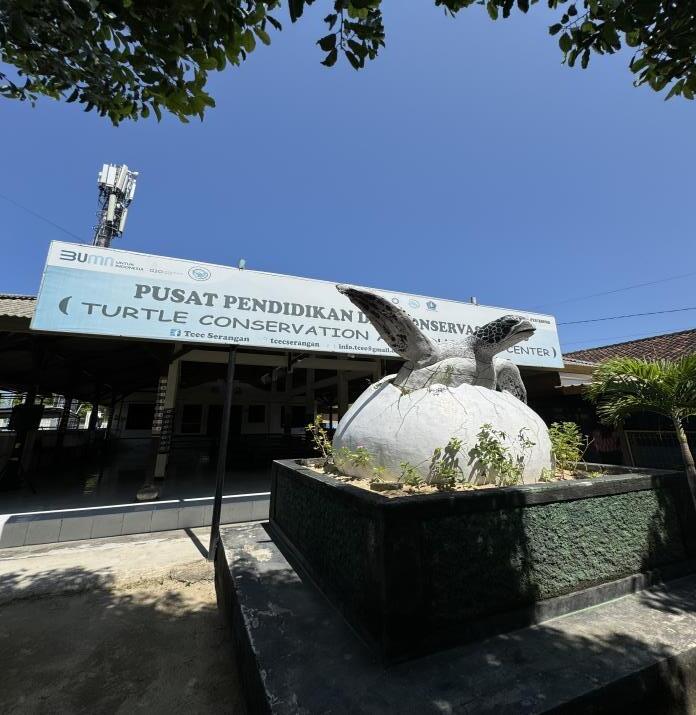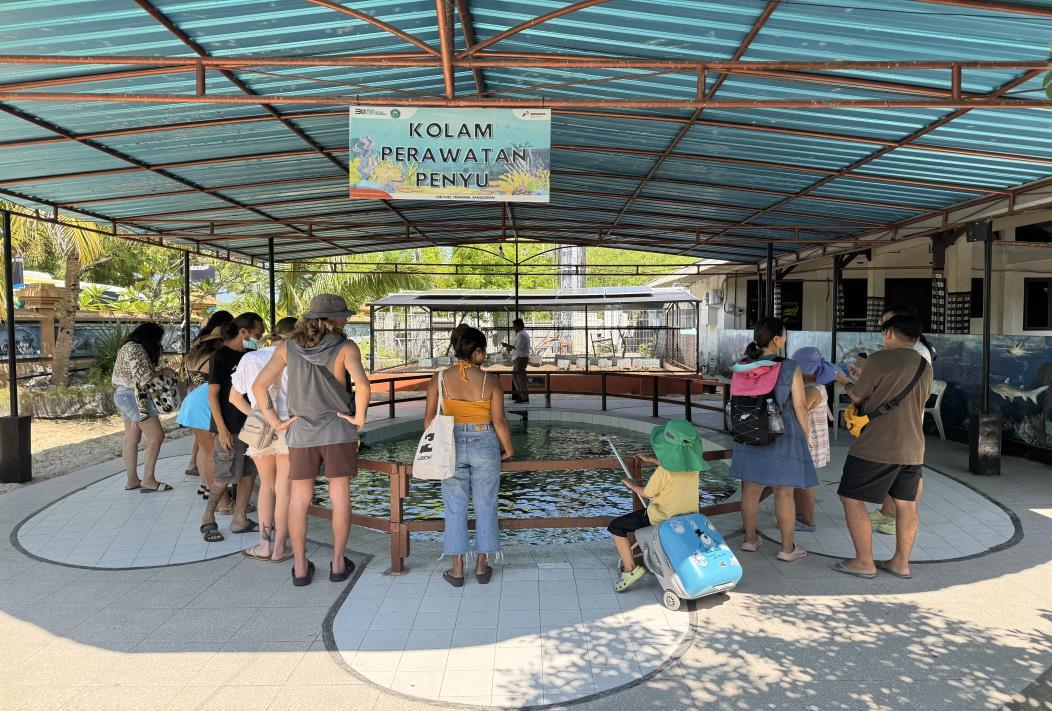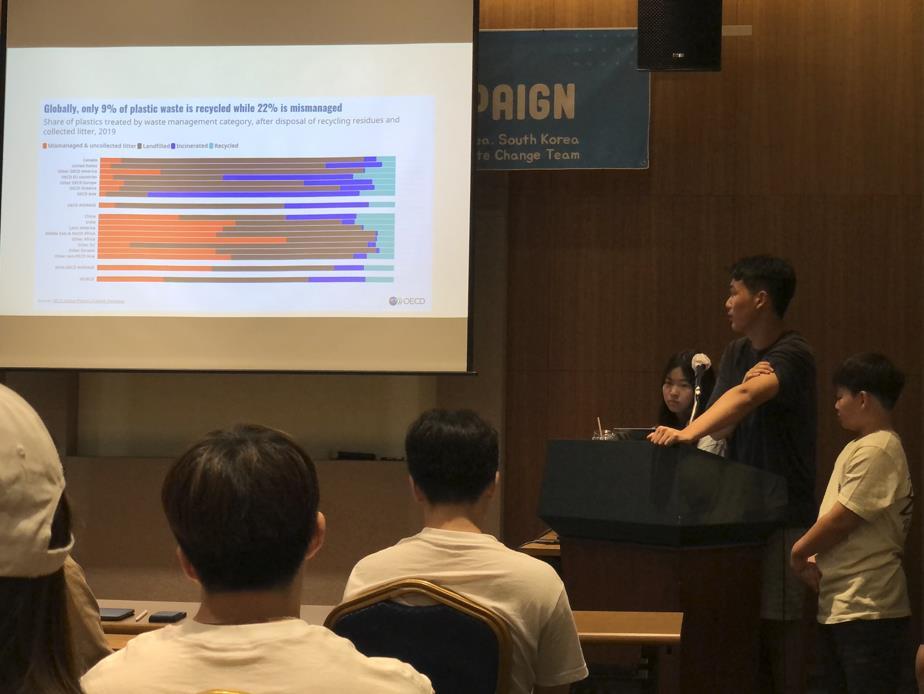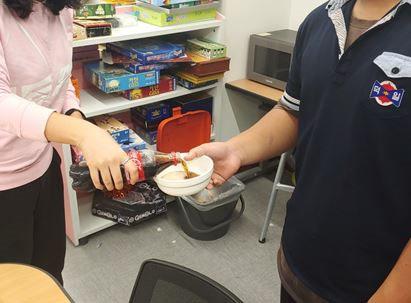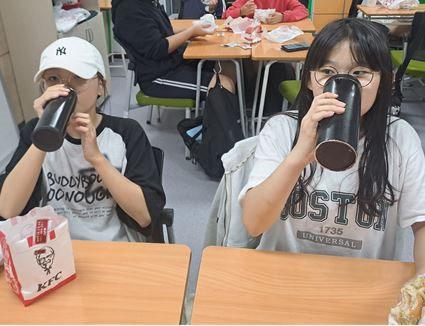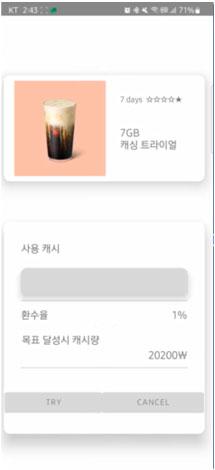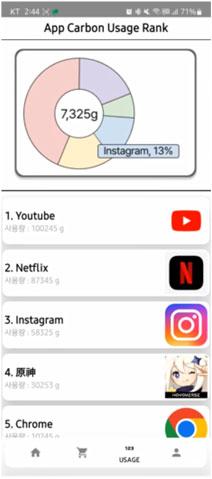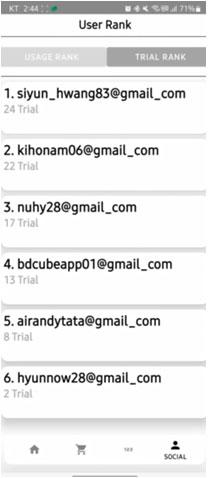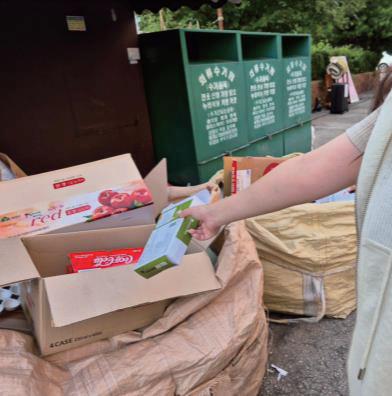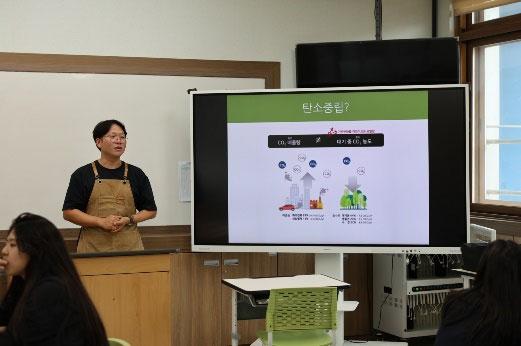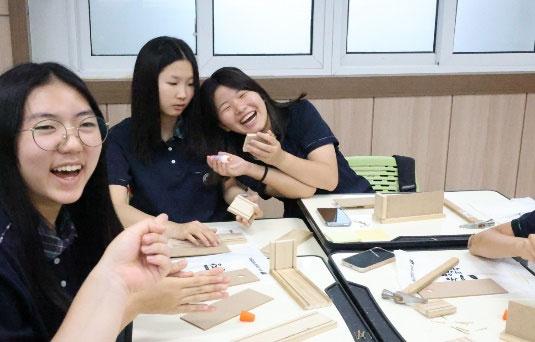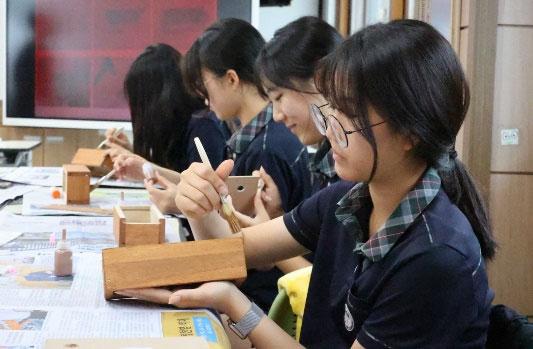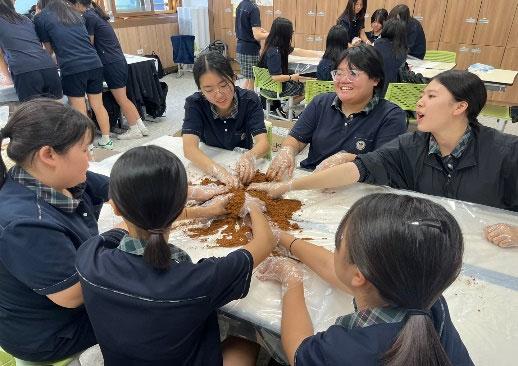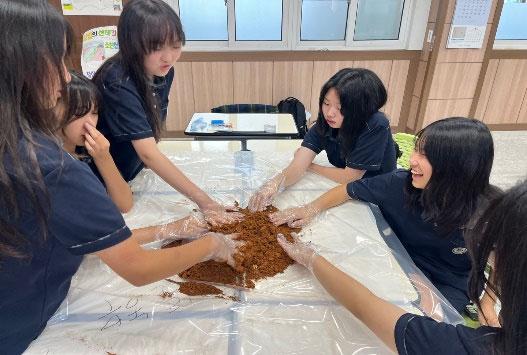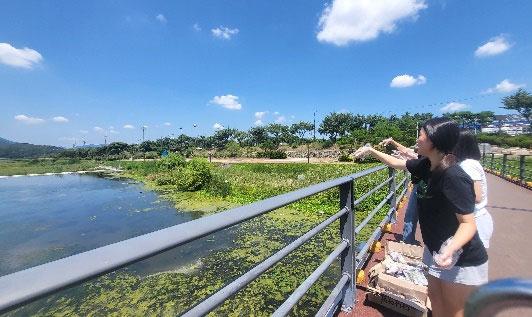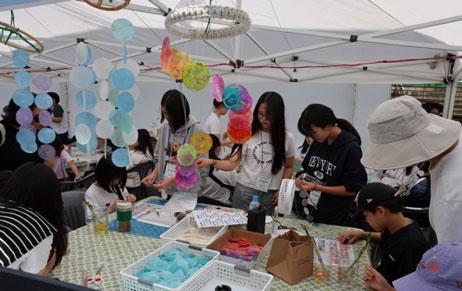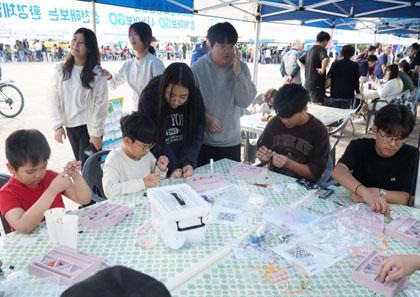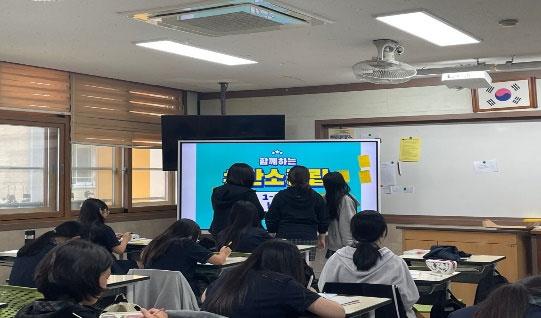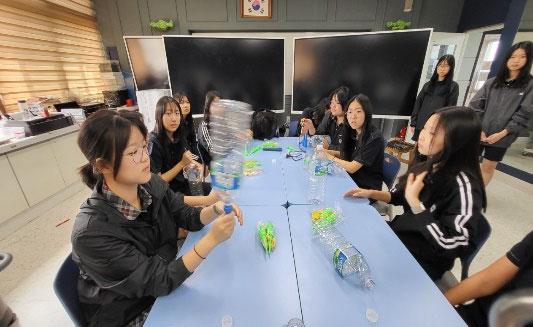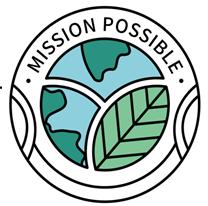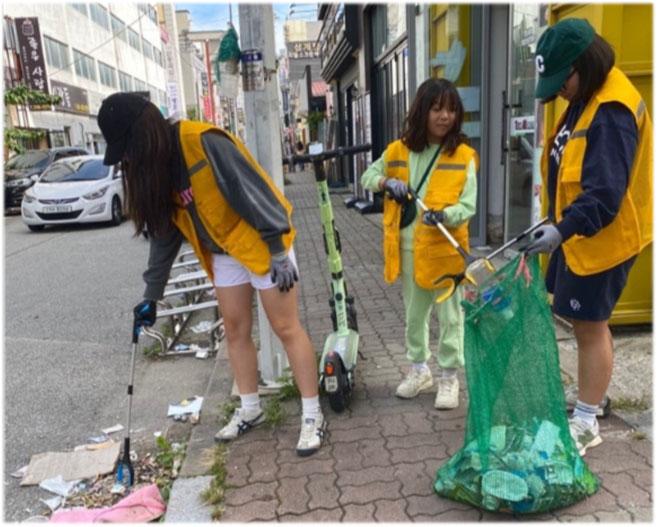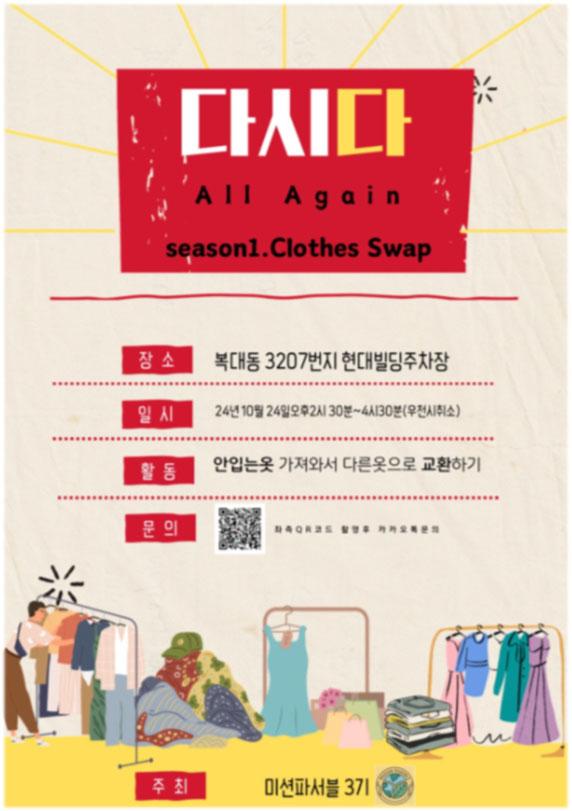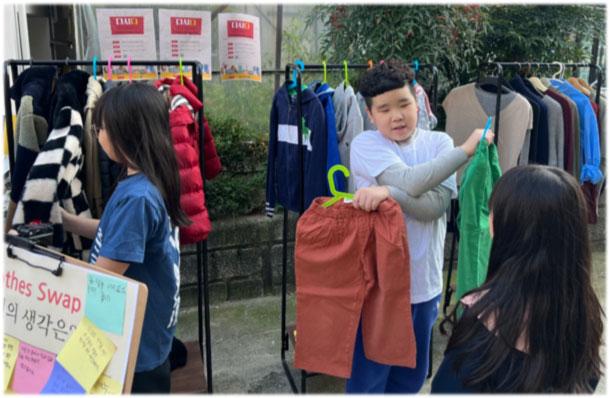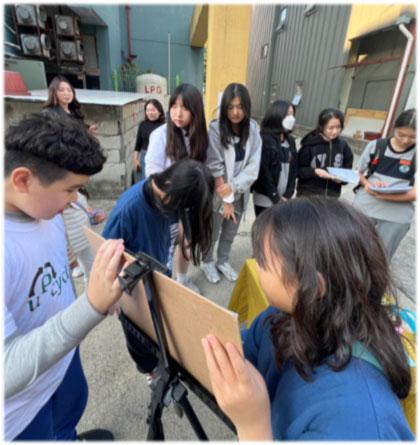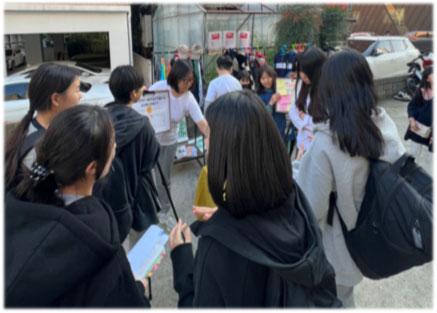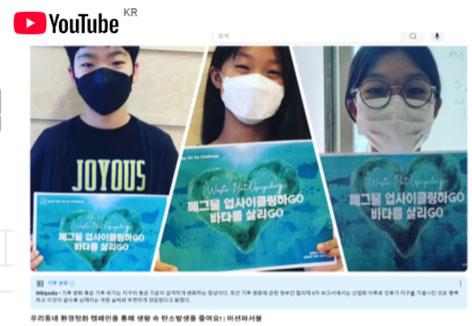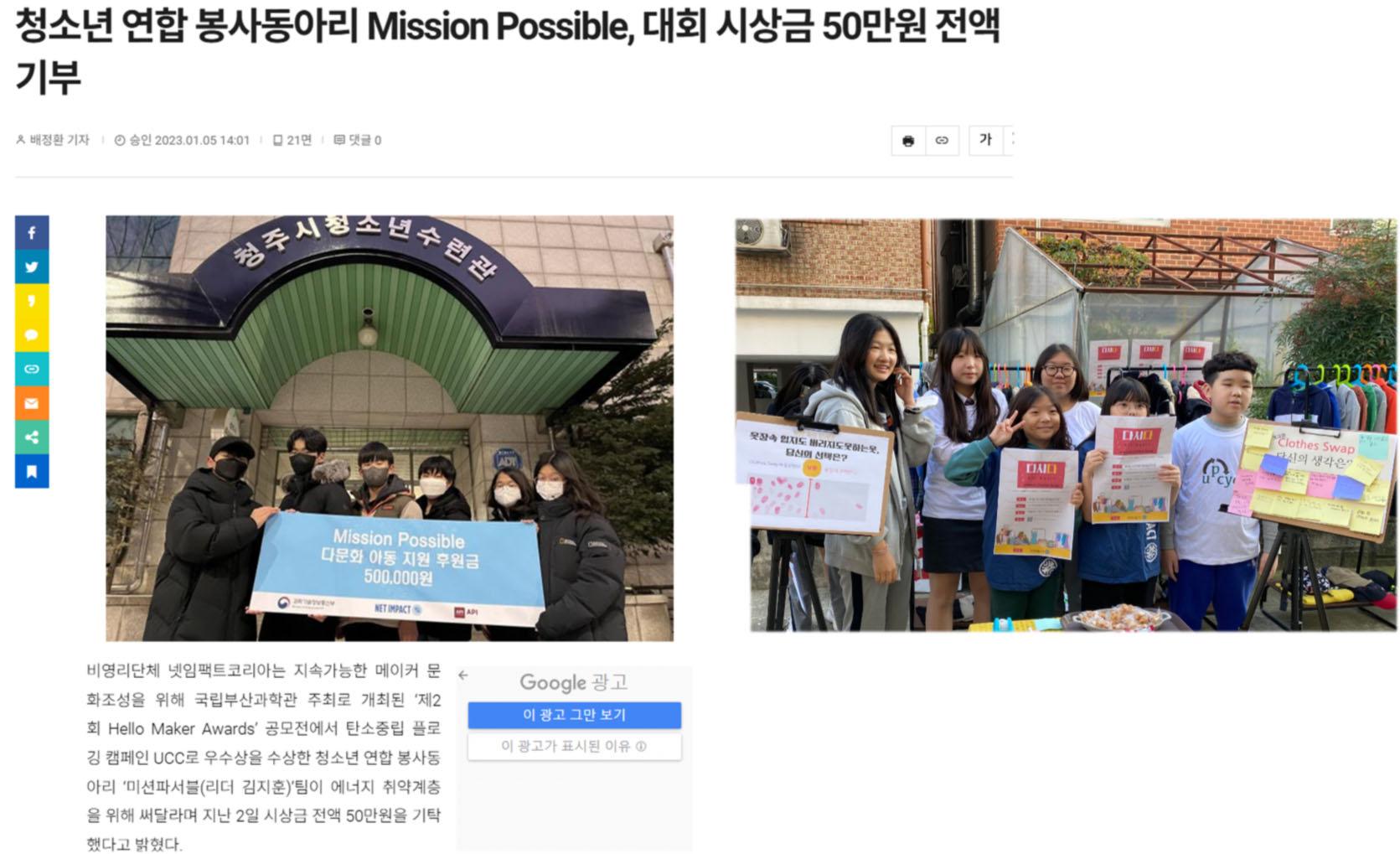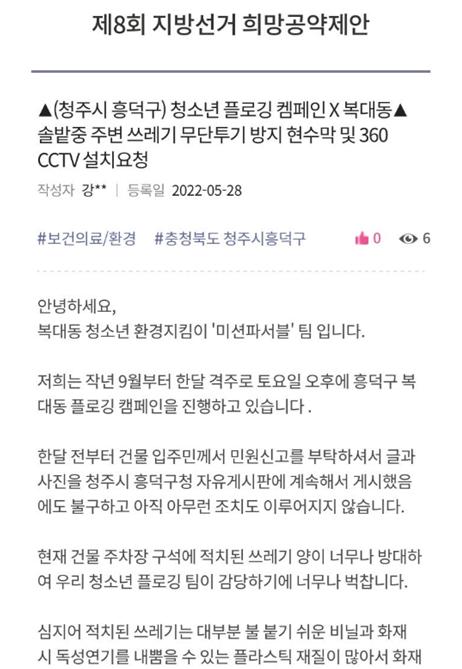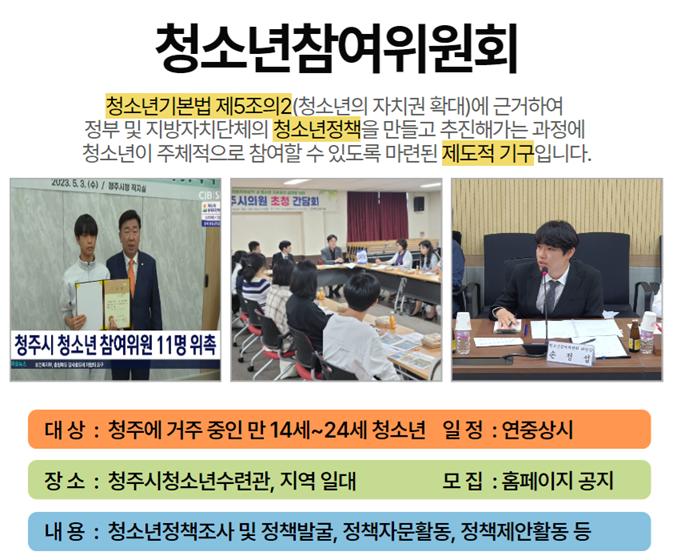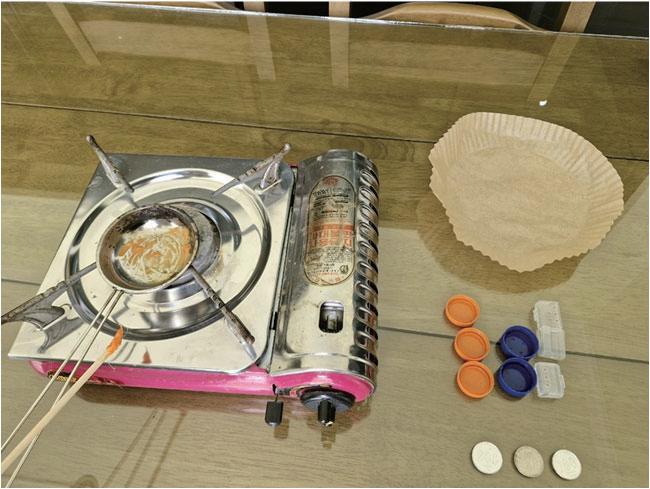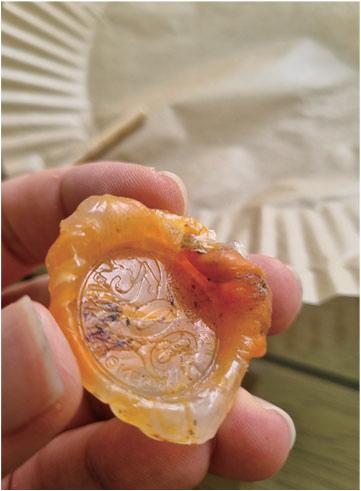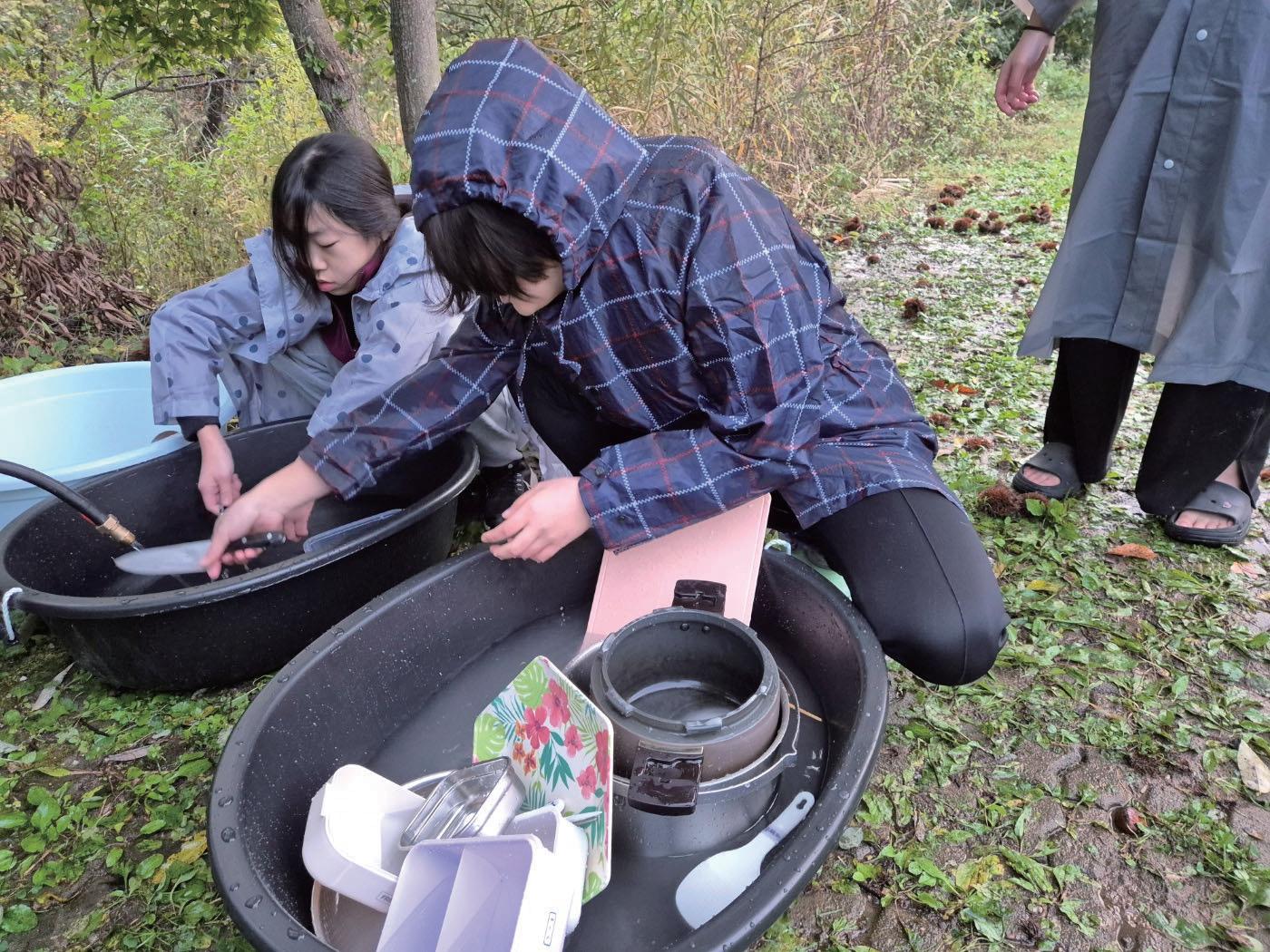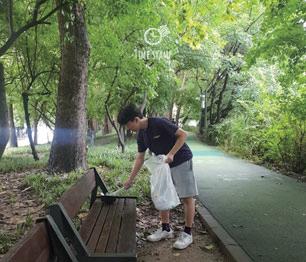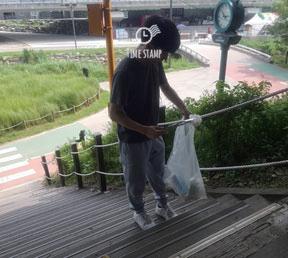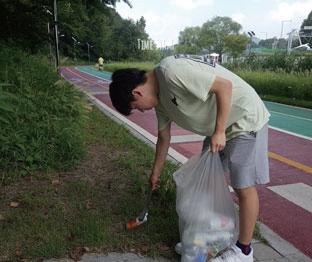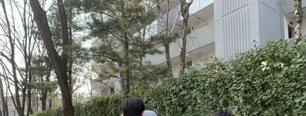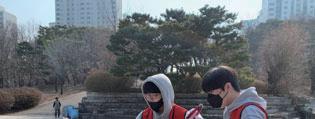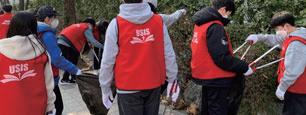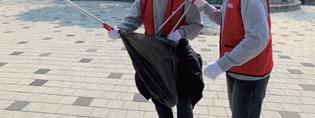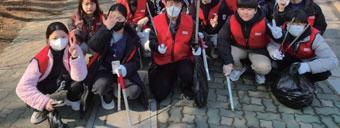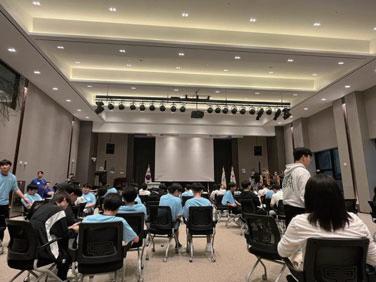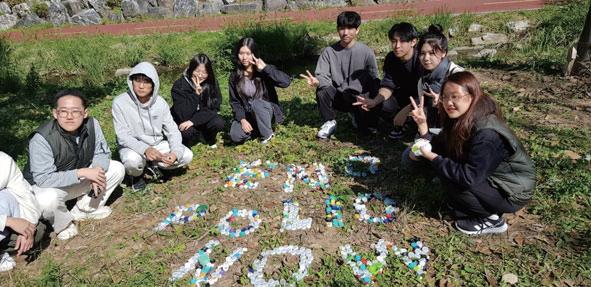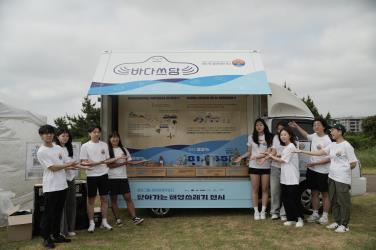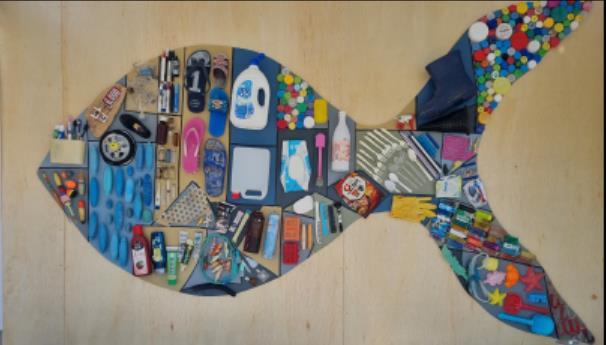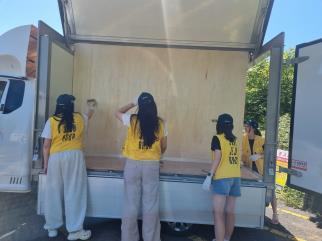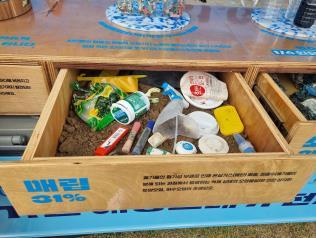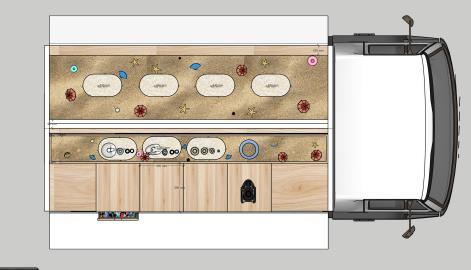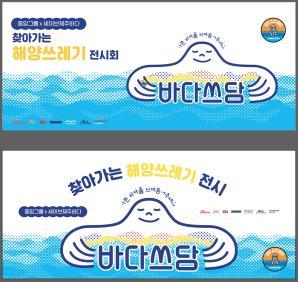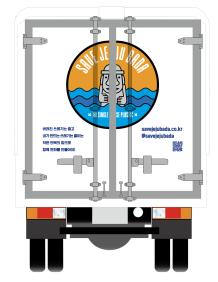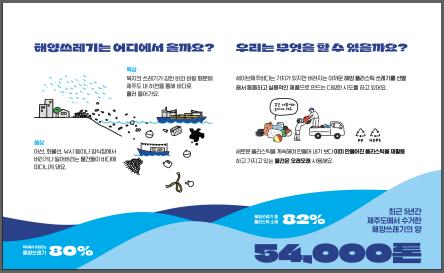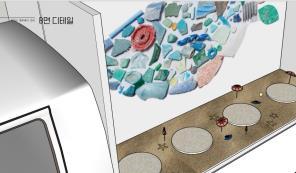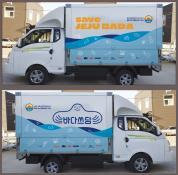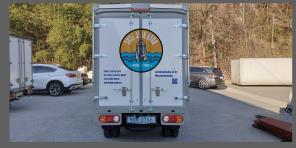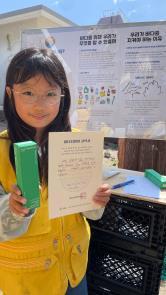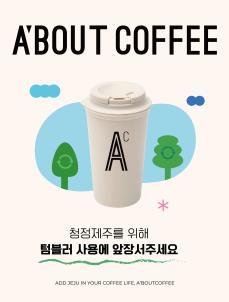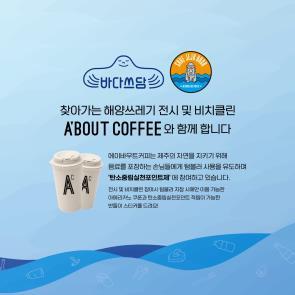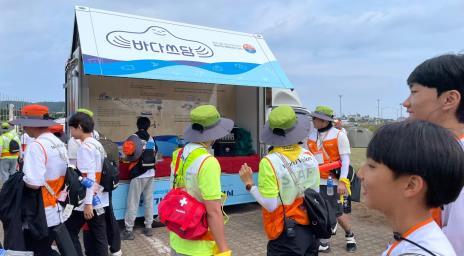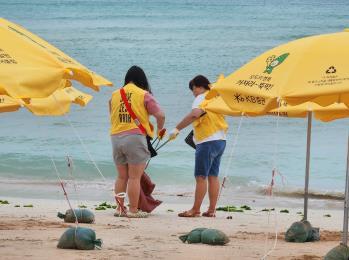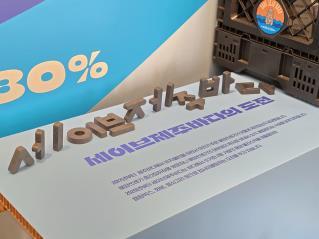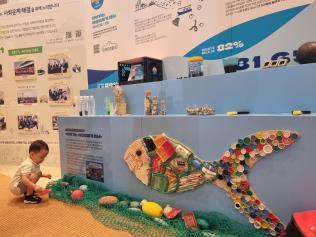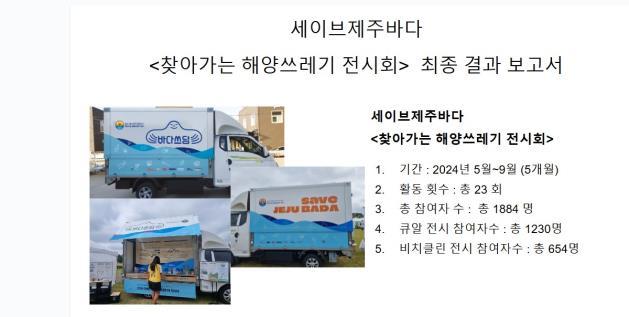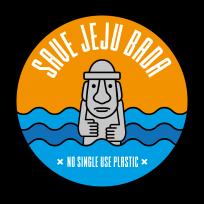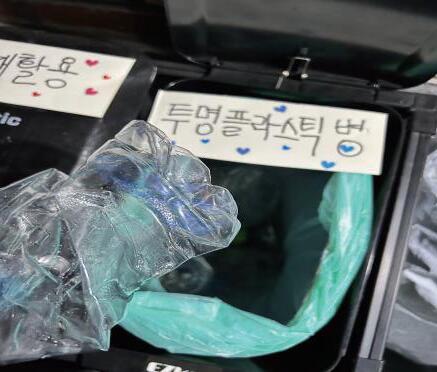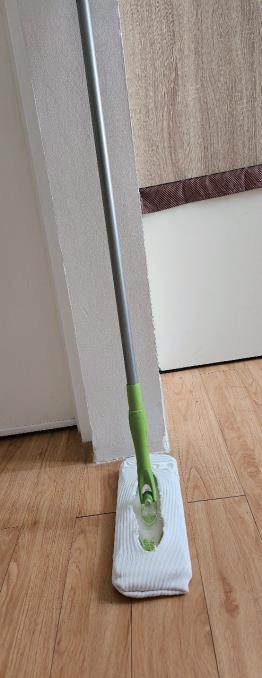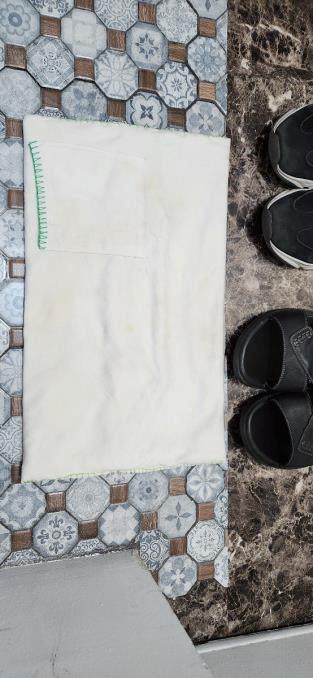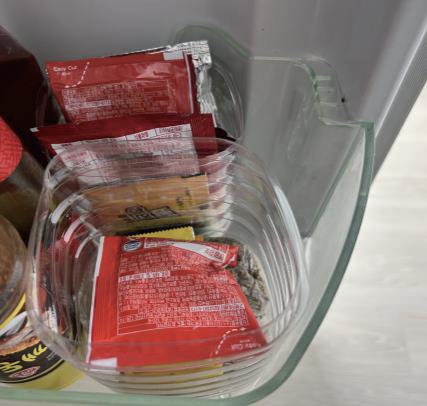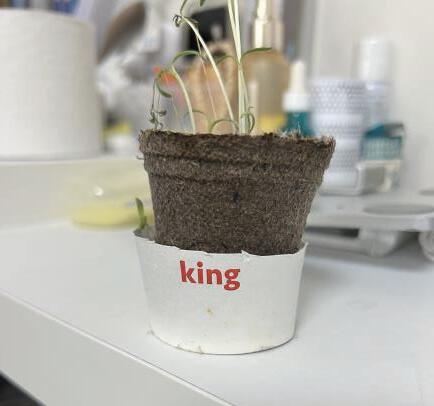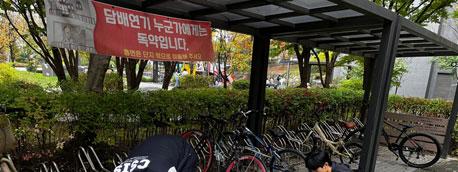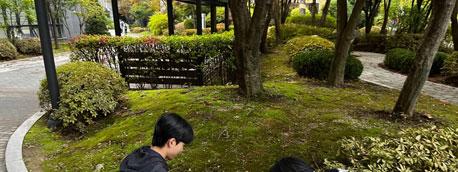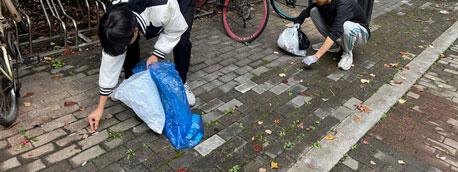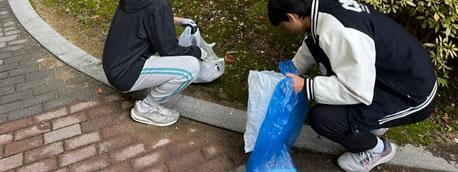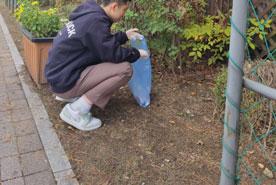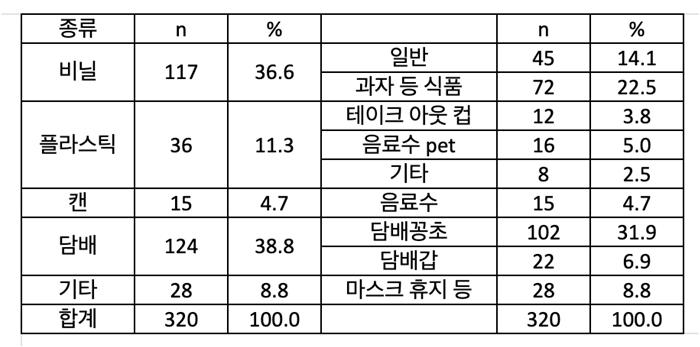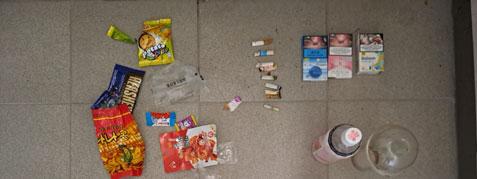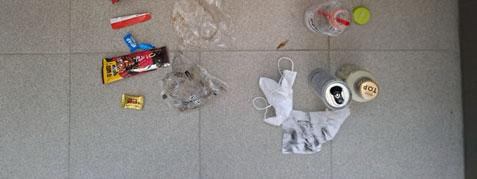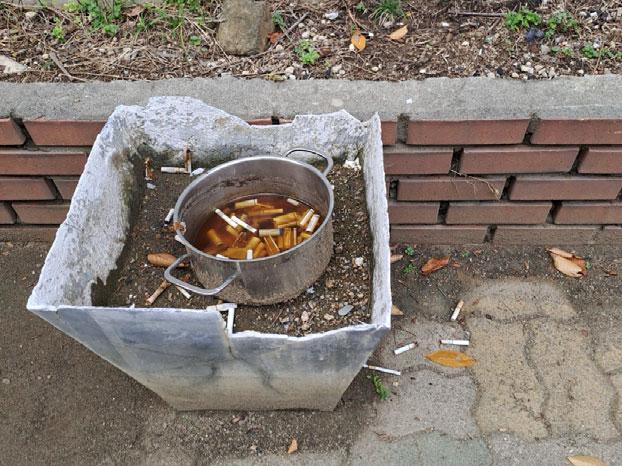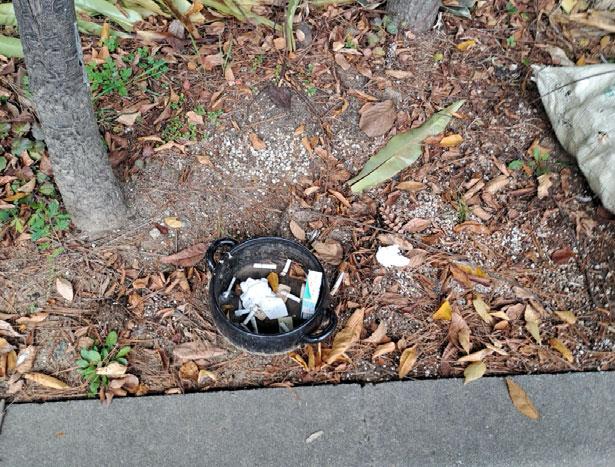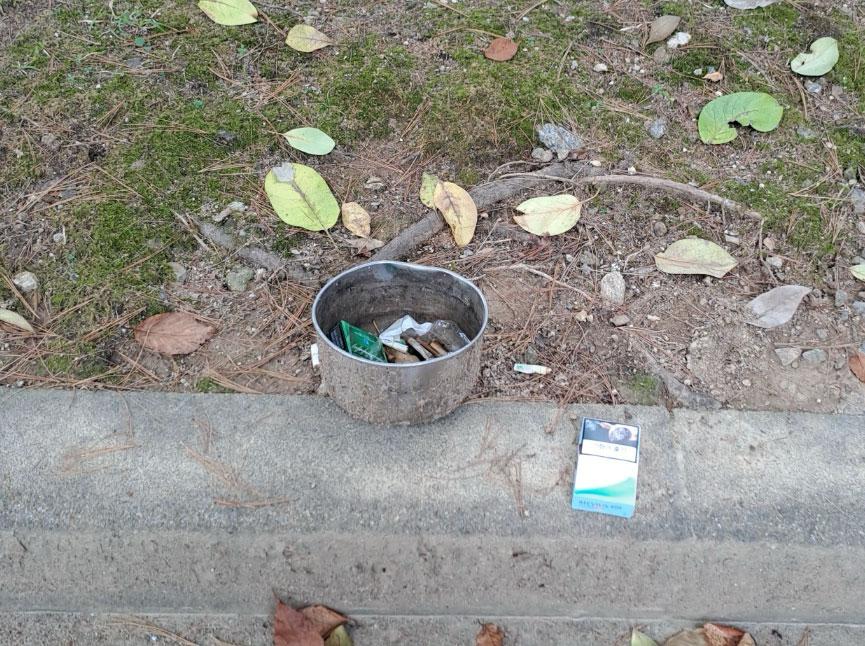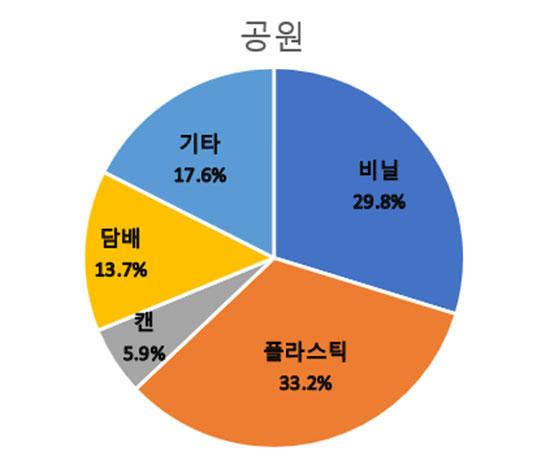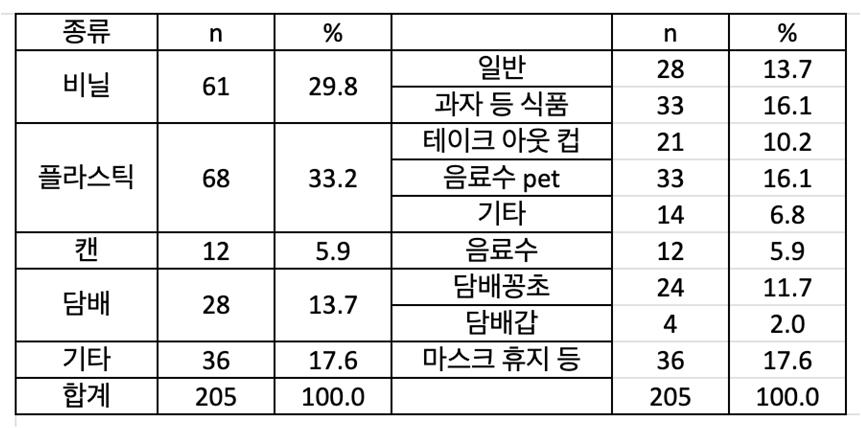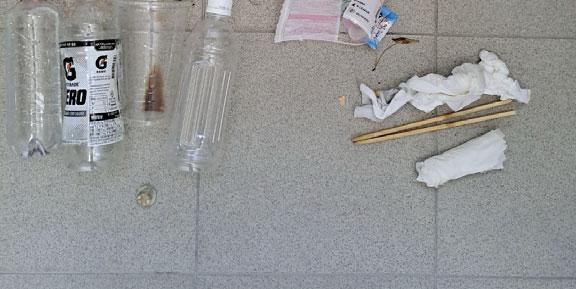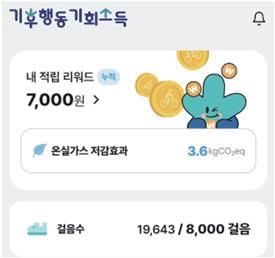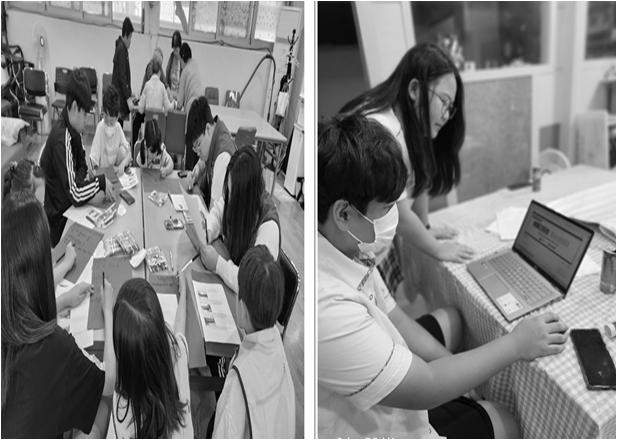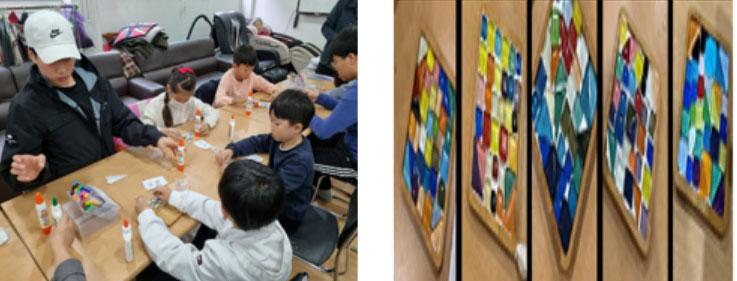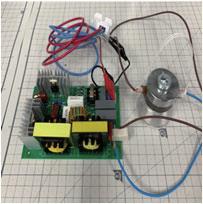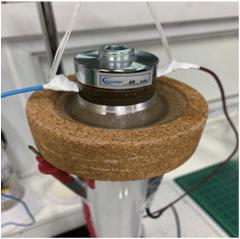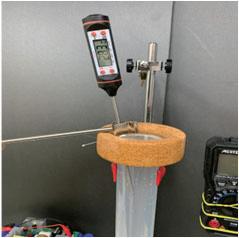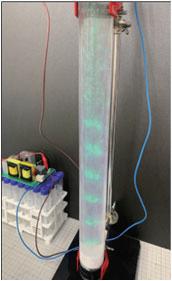RECRAFTERS
Team Name: ReCrafters
Name(s): Dayeon Kang, Seunghee Kim, Yoobin Seo, Seoyeon Choi, Soobin You
DURATION
Established in June 2024, we meet twice weekly on Tuesdays and Thursdays, with additional monthly meetings f Þrst or project updates. We are currently packaging and preparing for the sale of our handmade products. We are also planning on recruiting more members after our Þrst year, in June 2025, from which we will unfold a new milestone for our club.
Our club Þrst went through a stage of discussions and drafting a design of our products. We brainstormed and shared ideas about upcycling products and modiÞed and drafted a proposal that incorporated everyone’s ideas, marking the initial establishment of our club’s long journey. We also divided roles within the team, with Dayeon, our club's leader and treasurer, in charge of the overall project planning, Þnance, and social media campaigns. Seunghee, the co-leader and the public relations manager, supported the social media posts and worked on organizing events with Dayeon. Other club Members are Seoyeon - the marketing director; Soobin - the designer; and Yoobin - the event coordinator.









With the lead of Soobin, our designer, our team designed an ofÞcial logo that will be used on our products, which we later customized into a stamp. Through long discussions and debates, our club Ultimately came up with six main upcycled products: keyrings, popsockets, cup coasters, cup holders, dream catchers, and sun catchers, as the products that we will make and sell. So far, we made keyrings and popsockets by reusing plastic bottle caps.
For both products, we melted plastic bottle caps, which we gathered from our school community members. First, the plastic bottle caps were melted, and we stamped our custom-designed logo onto the hot plastic. Once it is cooled and
hardened, we cut them into circular shapes. For the keyrings, we penetrated a hole before the plastic cooled down and stuck in the keychain to the hole. For the PopSocket, we skipped the process of making a hole and instead attached it to a clear PopSocket.
We currently have created a total of 17 PopSockets, 9 mini keyrings, and 30 keyrings with our team logo. Through continuously recrafting products, we aim to reach a goal of making 50 of each product.
OUTCOMES/ FUTURE PLANS
We have gained some outcomes through our work on social media and the steady increase in our followers and people becoming motivated. We also started and spread the challenge for people to collect bottle caps and even brought this into action in a company as well. For the tangible profits, we will be beginning our sale in December, and the money received from winning the competitions will also be donated.
For our future goals and activities, we are going to gather fabric or products that are going to be thrown away, such as clothes for people who are oversized. We are going to cut them into long pieces, and after we make the shape of a circle, we will cover the circle with fabric and make it into dreamcatchers and
In addition, we are going to make cup holders using recycled paper.
ACTIVITY DETAILS (continued)
Team Name: ReCrafters
Name(s): Dayeon Kang, Seunghee Kim, Yoobin Seo, Seoyeon Choi, Soobin You

Through crafting the products we ultimately aim to open a fundraising upcycling shop where we will sell our products to our school community and parents. We will package the keyrings and PopSockets individually with some snacks and a paper that contains some information about the dangers plastic causes and a small mission where the students submit a short answer to the quest ion and we will select a few people randomly and they will receive a small gift each. Additionally, all profits from the fundraising shop will be donated to an environmental organization. By donating the products and selling them, we seek to spread awareness of the detrimental effects of plastic causes and also encourage people to reuse or recraft unused or unwanted products into new ones. We are planning to start promoting our shop by the end of November and start our sale in early December. Later in May and June, we will open another fundraising upcycling shop for our other upcycling products: cup coasters, cup holders, dream catchers, and sun catchers.
However, our efforts do not end here. To raise environmental awareness in our school, we made several posters that introduce our products and showcase our objectives and goals by taking the initiative through our club. The posters were also published in our school’s monthly newspaper and also pinned on the schoolboard so the other students could be aware of the problems and introduced to an innovative solution: upcycling.
Our club also participated in the “제9회 미디어창작콘테스트 우리동네 ESG 이야기 시민영상콘텐츠 공모전”.
In our video, we explained the seriousness of plastic and unwanted or unused products in our everyday lives. However, we introduced a solution to this issue by introducing our club and showing our efforts to recraft the products and plastic as a product that everyone wants to have.
We also brought attention to our club and what we are trying to do as a team through social media. We created an Instagram account, and until now, we have gained 25 followers and have interacted actively with people on social media who are also upcycling products. After every club session, we have been actively updating our work on our Instagram account. We have also uploaded promotional posts of our products and an overview of our club activity bimonthly. We also uploaded a video that gives an overview of our activity on our YouTube channel.
Through active engagement in social media, in-school promotions, competitions, and the continuation of recrafting products during club times, our club ultimately aims to create a sustainable club, not just a club that ends within ourselves. By actively promoting and encouraging people to follow in our footsteps, we want to form a community where people learn to look forward to the outcomes of their actions,



whether big or small and make wise decisions. Even you reading this paper would have at least once thrown away a bottle cap together with a plastic bottle without even knowing how much detrimental effects it can cause to the environment. Yes, it is just a small action done by an individual, but around the world, there are millions of people doing the same thing, and when these actions are compiled, they will eventually have a lasting effect that comes back to us. Therefore, you and I, as individuals living on this planet Earth, should be responsible for our actions and think before we do something because as time passes and each of us fights for the Earth, it will show through our lives. This is our driving motive and initiative that set us in motion for doing all these activities.
This is who we are. Team ReCrafters.
Team Name: Villanova Prep
Name(s): Jimin, Kristine, Isabel, Junyoung, Ryan
OBJECTIVES DURATION
Jimin, Ryan, Isabel, Kristine and Junyoung. We, individuals who walked through totally different paths, gathered here in Villanova preparatory school by serendipity and are walking abreast. Us, with contrasting stories and circumstances are relying on each other with deep empathy owing to our commonality as an international student from Korea and consistent love in the environment: Considering that our first encounter was via environmental club, we could confidently say that our concern in the environment have united us as a group. Regardless of the fact that this coincidence might be ephemeral as the time flows, we would always desire to reunite based on our concern for the environment, continue to sequentially suggest and encourage interest in the environment.
ACTIVITY DETAILS
• Middle school work
2024-10-01 ~ 2024-11-01
1. When I was in middle school in Korea, I was the class president, so we usually met once a month with every class president, class vice president, school vice president, school president, and teacher. At that meeting, to protect the nature of the school and the surrounding parks, we suggested the school pick up trash or try to protect nature, even if it was just a simple thing. As a result of suggestions made at a meeting, signs to reduce plastic use and protect the environment appeared throughout the school, and the number of students picking up and throwing away trash near the school increased rapidly.
2. In middle school, during World Environment Day, we began a program for making eco bags to save the environment. For that program, my friends and I zealously made eco-bags. In order to make people more aware of the natural environment, I drew a picture on the eco bag of a dog look front because I wanted to encourage people to think more carefully about nature by drawing puppies, which are people's favorite animals. Also, I made several eco bags for my family members for their daily use, in order to reduce the use of disposable plastic. I have been use ecobag a year. By doing so, I have kept hundreds of disposable plastic bags from being thrown away.
3. During the Morals class in middle school, my teacher gave us an assignment to upload videos of actions taken to protect nature. As part of that assignment, I filmed two different videos. One is a video of putting items in an eco-bag instead of a plastic bag after buying them at a mart, and the other is a video of buying a drink at Starbucks and kindly asking the employee if he can put it in the tumbler that I brought. This helped me to realize that small actions can have a big effect on our environment, so I kept using a tumbler and eco bag. Also, during Morals class, my friends and I had an assignment to change the lyrics of a common song, substituing a message of protecting nature. We edited the video ourselves and and showed it to other classes. This was a fun way to raise environmental awareness, and the song was catchy so the message got stuck in the heads of all of the students.
• Malaysia school work
1. When I was in school in Malaysia, there was a school system where each student would join a team and compete for points. There was an event once a week where each team would compete to see who could recycle the most. It was called Recycling Day, and for a week, each team would make a recycling bin at school and check it on Fridays. The team that collected the most recycling waste would get points. For this recycling day, I made a great effort to ask many teachers and friends to protect the environment by recycling.
2. There was also a program called Explore Week once a year, in which I could experience and feel Malaysian nature firsthand. Through this program, I was able to get closer to nature, sleep near nature, and realize the value of nature up close. During this week, I also went near a Malaysian public school and picked up trash. As a final project during Explore Week, I worked with my friends to build a boat using recycled waste materials such as pipes and plastic string. The boat floated well, demonstrating how useful recycled materials can be.
3. In science class, we learned about Malaysia's ecosystem and observed it in detail, taking pictures to help us feel and understand the value of nature. We then wrote up our observations for each plant that we studied. The results of our research, our photos and writings, were shared with the entire school, generating a great response.
• In everyday life work
1. Whether in Korea, Malaysia, or the United States, I always try to recycle the waste from the things I use. For example, I separate the labels from plastic bottles and throw them away separately, or I separate the tape from the boxes I receive. I try to protect nature in small places in my daily life.
2. In order to reduce the use of disposable items, even just a little, I prefer to go to restaurants or to make my own food rather than having it delivered. There are too many disposable containers, forks, spoons, chopsticks, etc. that come with delivery. However, if I do have delivery, I ask them not to give me disposable spoons, forks, chopsticks, etc.
America environmental club work
1. This is the same thing that Isabel and Ryan, my friends, did in the next chapter.
OUTCOMES/ FUTURE PLANS









Participating in '탈플라스틱 실천활동 공모대전' have allowed us, Villanova to share valuable perspectives derived from personal experiences, coinciding with achievement of every member’s personal development via reflecting in ourselves more deeply. Cooperating with five team members allowed us to listen courteously to diverse opinions derived from different backgrounds throughout the process. This enabled us to expand our perspectives of viewing the world, also contributing in our improvement of our consideration in others with understanding in environment itself. With appreciation, we were able to elaborate our interpretations toward the environment and have efficiently concluded our work by due date. Our determination to participate in this contest has provided us with a run-up for future development through cherished experience, awakening us to the true value of cooperation. With new lessons learned, we are better equipped for future opportunities to indicate our concerns toward the environment. Furthermore, refraining from ourselves neglecting environment relevant activities in daily life, we would continuously be engaged in applying our enhanced knowledge to everyday life. Through enthusiastically participating in environmental club activities as a team, we would gratefully be the epitome for other students, encouraging them to join the environmental community as a presence existing on this earth.
Jimin Nam
ACTIVITY DETAILS (continued)
Joo Hwan (Ryan) Kim
On Campus:
1. Service Day:
Team Name: Villanova prep
Name(s): Jimin, Kristine, Isabel, Junyoung, Ryan
• Every year, my school holds an event called Service Day, where each pack (group you are assigned to) is randomly assigned an environmental task to support local communities. It’s an event that brings us together to make a positive impact in our community and environment. In my freshman year, my pack went to a local farm where we worked to clean the soil, remove weeds, and help with general upkeep. Then, in my sophomore year, I helped another farm by removing plastic coverings used to protect crops from winter weather. As a junior, I’ve only experienced Service Day twice so far, but I will have the chance to participate two more times before I graduate. I think service day is very important because we get to work together as a team while helping care for the environment and supporting the community. Each year I feel very proud after I am done with my assigned work, thinking that I helped the local community.
2. Environmental Club:
• I’ve joined the Environmental Club since my sophomore year and have become more active since then. Recently, I’ve taken on more responsibilities, like making sure everyone knows how to compost and setting up informative posters in noticeable areas around the school. As the commissioner of public relations, I informed and demonstrated composting in a whole-school morning announcement. Now I’m looking forward to an upcoming beach cleanup event in Ventura, which will take place in about a month. I am very happy that I joined the Environmental Club because I get to make some positive impacts on our school campus and go outside of the school to participate in some volunteering services with my friends as well.
Off-Campus:
1. Citizens’ Climate Lobby:
• The Citizens’ Climate Lobby (CCL) is an organization focused on gathering people who are interested in the topic of climate change and discussing the possible solutions to it in a meeting. The best thing about joining the organization is that I get to meet people who are passionate about environmental change. By attending the meetings, I get to share my own thoughts on possible solutions to climate change and how youth involvement is needed to shape a sustainable future. As one of the younger people in the organization, I learned so much from the people who did this for a couple of years. By listening to their outstanding thoughts, I realize how much I still need to learn about this topic. I am interested in seeing how experienced members turn ideas into real actions. One member shared a story about organizing a cleanup at a local river that had been polluted with trash. They gathered volunteers from nearby schools and community centers, and together, they spent an entire day clearing the river, removing plastic waste, and even planting native plants to restore the area. Hearing these stories motivates me to do similar things, like making a school campaign and encouraging my friends to compost. It also shows me that small actions, when done together, can make a big difference. Being part of CCL has taught me that young voices are important in the climate movement, and it keeps me motivated to keep learning and improving in this area.
2. Big Wave Organization:
• Big Wave is South Korea’s biggest youth climate organization, helping young people get involved in fighting climate change through education, events, and partnerships. Supported by companies like Patagonia, Big Wave works with major groups like POSCO to push for greener practices in areas that have a big impact on the environment. Since most events happen in Korea, I have to join online meetings when I'm in the U.S., and when I visit Korea, I attend as many in-person events as I can. Big Wave is a very active organization that impacts many things happening in Korea. It is very interesting to see what changes they make, and feel proud to be part of the group that makes changes. While volunteering in person, I did things like passing out flyers to people to inform them about climate change. Even small tasks like this showed me how everyone’s effort adds up to make a difference. Even though my position in Big Wave can’t do as much as more experienced people, I am passionate about making a difference in representing the organization in the future.
3. Blue Ocean Competition:
• As the leader of Villanova's business club, I participated in the Blue Ocean Competition with a team of four members. Which is a business idea competition yet it needs an environmentally friendly factor. We aimed to create an environmentally friendly but profitable product. We focused on the significant waste generated by disposable feminine products, contributing approximately 200,000 metric tons of landfill waste each year. These products often contain plastic, with pads taking up to 500-800 years to break down, and plastic applicators breaking down into microplastics, further polluting water systems. Over a lifetime, the average woman disposes of nearly 10,000 kg of these products, highlighting the need for sustainable solutions. Our proposed solution involves setting up many collection bins to collect used feminine products, which are then processed in a special recycling machine. The recycling machine will separate and disinfect the waste, extracting the reusable materials, such as cellulose and plastic. These are then recycled into new products, giving value to what was considered simple trash, therefore not reaching the landfills. This approach meets consumer needs by transforming waste into usable resources while promoting a circular economy, where products are continually reused, minimizing their environmental impact.




ACTIVITY DETAILS (continued)
Team Name: Villanova prep
Name(s): Jimin, Kristine, Isabel, Junyoung, Ryan
• Have experienced suggesting solutions about progressing pollution targeting peers and teachers.
1. You all would have experienced producing a poster that encourages people to determine eco-friendly actions. “Let's do recycling!”. . . “The earth is suffering from various pollutions”. . . I found that these quotes were dominant in the majority of posters when doing research. However, despite it attracting numerous people to choose it, I believe that it might not motivate people to fulfill its idea to action. Therefore, when composing my ideas, I desired to produce a poster that actually motivates people’s mind and through producing effective posters with quotes that would trigger people to be conscious of the magnitude of the situation. First, in order to deliver my message effectively, I focused on describing the visual factor by consulting a variety of my expressions of art on the poster.Then, I thought about the quote that would encapsulate my intent briefly, and determined as follows: Progress beyond plastic: Embracing a future where progress is allergic to the planet. Contribute in paving the path to a sustainable world. Free from plastic. Gratefully, my posters were serendipity able to trigger peer’s empathy and compassion, allowing me to not only share but motivate others' determination to fulfill eco-friendly habits.
• Contributed to the improvement of living circumstances for generations coexisting as neighbors via the environmental club
1. Personally, since my youth, going to the beach was one of my favorite weekend activities with my lovers. With my affection on the beach, I have volunteered in beach clean up several times via the environmental club. Volunteering to clean up the seaside has boosted my interest in how humans are harming the environment unconsciously - despite numerous trash removal operations held every month, the ocean is continuously experiencing significant pollution due to lack of support and concern from individuals. While volunteering may not indicate noticeable results in a short period which might verge on to temporary effect, me and my teammates from the environmental club would continuously participate in the environment’s further improvement and encourage others to participate for long-term lasting effect.
2. Within our school, serious issues of composing food in the cafeteria have consistently occurred throughout a long period without improvement. Regardless of the environmental club’s numerous attempts to encourage and remind students to call action to compose properly through creating a poster and making an announcement several times, the situation was experiencing a plateau. Since this project required not only our hard work but also the cooperation of the entire school community, it was challenging for us to show noticeable improvement. However, recently, our cumulative efforts were able to convince the majority of students to compose their food, having radical improvements to be made in composing due to our analysis.
• Have fulfilled and applied eco-friendly habits in daily life and improved our actions.
1. Within our community, every Wednesday was considered to be a recycling day. Our family was also participating in this policy and contributed to the improvement of living circumstances for generations coexisting as neighbors.
2. Our family is using a garburator in order to fulfill accurate elimination of food residue. Attending various environment relevant classes, I realized how inaccurate elimination of food waste affects climate change, contributing to circulation of pollution with its methane gas; a powerful greenhouse gas. This helped me to be aware of my family’s inappropriate way of elimination, and to spend time together to figure out the way that is eco-friendly but maintaining convenience. After researching, we found a garburator product that decomposes food but minimizes the impact held on nature and has been using it for several years.
My parents used to think that doing chores are the most troublesome things to do. Especially, washing dishes. Therefore, we used to order food contained in disposable containers. Because of our action, our recycle bins for plastic have always stayed superfluous. One day, when we were recycling our trash as usual, we had to ask two helpers to be in charge of plastic trash because of the vast amount go plastic trash compared to others. This incident have become me and my family’s trigger to look back about our actions so far and reflect on our inappropriate behaviors of ordering food in disposable container. Hence, we thought about solution that would prevent us from unconsciously harm environment. We had a family meeting that day, and two solutions were suggested: First, to cook by ourselves by buying ingredients from grocery store, And second, to bring reusable containers to the restaurant and to bring back home. However, as a result, considering our lack of time due to each’s work, we decided to fulfill our plan to bring reusable steel container to the place and bring back home so that we can reduce our time conveniently and also save the environment! Similarly, after starting To be concern about the impact that disposable products have on the environment, we then replaced all disposable plastic tablewares into reusable products in order to actually contribute to the improvement of environment.





ACTIVITY DETAILS (continued)
Kristine Lee
• Volunteering in environmental community
Team Name: Villanova Prep
Name(s): Jimin, Kristine, Isabel, Junyoung, Ryan
1. I participated in Mesa community Mesa volunteer opportunity was held by the Mesa Farm Tiny Homes community. It is a community that provides housing, wellness offsprings, and community connection.The founder of the community, Dan worked with the LA family house at first. Later, he learned about the statistics of homelessness and the poor outcomes in society. He then decided to start a non-profit business for the people in need. Mesa provides farming work for the homeless people and also housing. They not only provide the work but also work with them for motivation. The service was early in the morning until lunch time over the weekends. I dug out weeds on the farm which helps advocate the quality of farming. Then, I planted trees and flowers. I met people from the Mesa Farm Tiny Homes community and friends from different schools in Ojai. I was the relationships that I made from the community service work was certainly strong since we had to cooperate with each other for the work. In addition, the participants were able to learn about the history of the Mesa community. During the volunteer work, people shared each other’s interest in the environment and other opportunities to volunteer for the environments around us.
2. minor ox community garden
I participated in a minor ox community gardenIt is located in Ojai, California. It is a community garden which is a shared place for gardening for the neighbors in Ojai. I helped them move soil into the sectioned gardening fences. It was early in the morning until the afternoon over the weekends. I was able to build new relationships with the volunteers who were some of the neighbors of the local area.
3. Ojai valley land serve area
Ojai valley is located in southern California. The land serve area was about removing plants that are harmful for the land(ruining the nature chain). It was after school time, so some of my friends could join me to volunteer. I had to remove the plants with my hands with the gloves on. During the work, I saw many land animals such as snakes and rats. People had to use several different tools for the work. My friends and I decided to be in charge of one tool so that we can get used to the tools that we are in charge of. Therefore, we were able to finish the work efficiently. Through this experience, my friends and I were able to learn farming tools technique and how great the team work can be for volunteer work.
• CBL
(Girls club which involves the contents related to science, environment, and nature.)
1. The name of the club stands for the name of the very first founder Clare Boothe Luce. I have attended several trips such as AMGEN and Channel Island. AMGEN is a biotechnology company which highly values environmental sustainability. AMGEN strives to reduce their impacts on the environmental and natural chain by reducing the natural source they use and emission they create. The trip to AMGEN involved a tour of the laboratory of the company(parts that are not unsafe or secured), interviews with the company members in each part of the company such as the biopharmaceutic laboratory and manufacturing center. I was able to experience an eco-friendly work space and the community which also have developed several technologies to make sustainable products.
2. Channel Islands National Park is located in California. I was able to experience the pure nature and how people should protect and respect the great nature. Channel Island has its own creature living only on the Island such as Island fox and Island night lizard. By observing these valuable creatures in a unique environment, I could feel why I should protect the environment which I could not feel in my daily life. When I learned about the rules in the Island such as that people touring the Island are not supposed to pick up any stones or sea creatures, I was impressed by how people are collectively protecting the Island. I recognize how people try their hardest to preserve the great nature in the Islands. Moreover, I was able to learn the spirit of the people who devote themselves to nature.
Junyoung Park
1. In my previous school's microscopic biology club, we were discussing a topic for a lab, and we did an experiment to see what was in our local river under a microscope. First, we collected water with an eyedropper downstream from a large local river to collect the sample of interest, and then we prepared it for viewing under the microscope, looking at it at different magnifications. We found tiny green algae, microorganisms, and small colored crystals in the sample, which our team members determined to be microplastics. We took pictures of our findings and created a poster for the school to warn students.
2. During a school science fair, I researched the effects of microplastics on our bodies and warned his audience. While there is still a lot of research to be done on exactly how microplastics work in the body, the presentation was based on the fact that when they enter the body, they are absorbed, hormonally altered, and accumulate without being digested. In addition, I presented how to reduce and prevent microplastics, and my friends who were not interested in microplastics were also alerted.
3. I participated in a geological exploration trip in my school's enrichment science class, and the main purpose of our trip was to explore the geology and model of the place we were traveling to, and to campaign against environmental pollution. Through this trip, we learned about the geological structure of Korea and the people who are still doing their part to prevent environmental pollution. As a result, our team proposed to our school students to limit the use of plastic, disposable products, and other products that cause environmental pollution. As a result, through the campaign to ban plastic products at school and the campaign to separate plastic, we were able to reduce the amount of plastic used in our school and feel proud of our contribution to the environment.
저희는 지역사회 그리고 더 나아가 세계적으로 환경이슈를 알리고 실제
매년 학기중 및 방학을 이용하여 캠페인, 플로깅 이벤트, 펀드레이징 이벤트, 환경보호, 탈플라스틱 챌린지(용기를 내세요)를 진행하며 이 과정을 다큐멘터리화 시켜서 지속적으로 우리가 살아갈 지구를 지키고자 활동 중입니다
팀 명 이름 팀원
Webring Environmental Studies Club & WOOF
Team Leader: 임예준 임예준, 김채영, 이세현, 최준혁, 장석휘, 신우진, 권지니, 이수종, 이정우, 임다혁, 정수아 2021년 3월~현재까지 (4년차 클럽)
1) Plastic Free Journey to Clean Ocean (속초 플라스틱 프리 환경 워크샵 진행) (2022.06 부터 매년 여름 진행 중) - 속초 바다 플로깅 진행 - 환경 NGO “OCEANKIND”와 함께 강릉 바다 플로깅 및 환경 교육 진행 - 환경 캠페인 진행 - 플라스틱 제로 실천 "용기를 내세요"플라스틱 대신 “용기"를 사용하여
진행(수년간 진행 중)
다큐멘터리로 제작하여 각자 학교에서 전교생에게 알리기
2) 서울 한강 플로깅 (플라스틱 및 쓰레기 청소) (2023.06, 2024.06) - 한강 지킴이 프로젝트를 위하여 서울에서 플라스틱 배출이 많은 곳 중 하나인 한강에서 플로깅을 진행하였으며 서울 한강(반포지구)부터 강남역 까지 플로깅 진행하며 거리에 있는 플라스틱 및 쓰레기 정리 진행 저희는 저희 환경클럽의 인원이 많아 지기를 원합니다 더 많은 사람들이 모여 더 큰 뜻을 위하여 세상에 울림을 줄 수 있는 환경 클럽이 되었으면 좋겠습니다 저희는 모금 활동을 통하여 얻은 수익으로 인도네시아 발리에서 해양생태계 살리기 프로젝트를 진행합니다 무심코 버리는 플라스틱으로 인하여 피해 받고 있는 바다거북이를 보호 할 예정이고, 내년도에는 미국 하와이 그리고 미국 남미 지역에
활동내용 계속
이름 팀원
Webring Environmental Studies Club & WOOF
Team Leader: 임예준 임예준, 김채영, 이세현, 최준혁, 장석휘, 신우진, 권지니, 이수종, 이정우, 임다혁, 정수아
3) 바다거북이 지키기 프로젝트 (2024.01~ 현재) - 1차 인도네시아 발리 방문 (2024.05) 인도네시아 발리에 위치한 바다거북이 구조센터와 계약 진행“바다거북이를 죽이는 플라스틱"이라는 주제로 프로젝트 진행 중
- 현재 환경 교육 전문가를 초빙하여 클럽멤버 전원 환경교육을 꾸준히 받고 있으며 플라스틱이 해양생태계에 문제를 일으키는 것을 이슈로 삼아 올 겨울 인도네시아 발리에 위치한 바다거북이 지키기
4) 미국 뉴욕 Marine Center 방문 교육 (2024. 09)
5) 팀멤버들 대부분 각자 학교에서 환경클럽(Environmental Science Club) 리더를 맡아 각 학교에서 환경 활동을 진행 중
환경 교육 진행 - 교내 환경 지키기 프로젝트 (탈플라스틱 캠페인)
ESG : 10 ESG , ,
: , ,
:
, , ,
ONE)
Two)
Three)
Four) :
ONE) ESG
Tw0)
Three)
(ClothesSwaps)’
https://youtu.be/9Gu9bgh_UsQ?si=GuUkR7WXi-a6TgQu
OBJECTIVES
Educating Society with Mixed Reality (MR)
ACTIVITY DETAILS
Introduction
Team Name:
Name(s):
JeongHoon Park
DURATION
Can you imagine life without our phones and other gadgets? The answer is probably not. Most people spend hours and hours watching things on YouTube, streaming movies, and chatting with friends online. Yet, those same people don’t get how much using the internet and these gadgets can be to the environment. Every time we stream or play online, we need energy from giant computers called data centers, and that adds to the world’s carbon footprint. Plus, when we keep buying new phones and laptops, we often toss the old ones out, creating e-waste that pollutes the planet.
I am from South Korea and in our country using technology seems unavoidable. The great thing is that this gives us a special opportunity. I believe that South Korea can lead the world in digital sustainability if we all learn to balance our love of technology with caring for the environment. But just saying “stream less” or “recycle” doesn’t always help people understand just how dangerous our environmental footprints can be. But, what if we could see the impact of these things in real life? What if we use Mixed Reality (MR) to help? MR is a cool new technology, a combination of Virtual Reality (VR) and Augmented Reality (AR) that could make learning about the environment more fun and even teach us how to create habits that truly make a difference. My essay and plan is to show how South Korea can use MR to teach students about sustainability and lead the way to a greener future.
Why
the Internet and Technology Can Hurt Us: E-Waste
Most people don’t think about the internet as a pollution problem. However, streaming videos, playing games, and scrolling on social media (what my teacher called ‘doomscrolling’) all waste energy. That energy comes from huge data centers that have to run all day and all night. Can you imagine a factory that never shuts down!? An hour of streaming is the same as pollution as driving a car for about 3 kilometers (Harding, 2023)! If more people are using YouTube, Netflix, and KakaoTV, the more electricity they will need and the bigger the carbon footprint.
OUTCOMES/ FUTURE PLANS
On page 3
ACTIVITY DETAILS (continued)
Name(s):
JeongHoon Park
But it’s not just about wasting energy, e-waste is also pollution. In South Korea, this problem must be very big because people love upgrading to the newest tech. But what happens to the old devices? A lot of them end up in the trash and become e-waste. Then they are taken to landfills, where they just sit and create toxic chemicals that hurt the earth. And, though South Korea is great at developing new technologies like Samsung phones, we still need better ways to recycle and manage all the waste from our tech trash. I believe that MR can help to make us better understand and fix the problem.
MR Can Help Us Better Understand What is E-Waste
It’s hard to explain how digital consumption and e-waste hurt the environment with just the teacher’s words. That’s why MR is such a powerful tool—it can help students see the impact of their actions as if they were happening right in front of them. Here are three ways MR can change environmental education in South Korea:
1. MR Simulations on the Carbon Footprint of Internet Use
Imagine wearing an MR headset that shows the energy consumption of each online activity in real time. For example, when you stream a YouTube video, the MR simulation could show virtual smoke rising from a power plant or icebergs melting because of the energy used. This would help students see the invisible impact of everyday habits like streaming or gaming.
2. MR Recycling Lessons in Virtual Labs
In virtual MR classrooms, students could take apart 3D models of smartphones, learning how each part can be recycled—or not. Schools could hold MR competitions where students design the most ecofriendly gadgets, giving them a chance to come up with creative ways to reduce e-waste.
3. Virtual Field Trips to Green Data Centers and Smart Cities
Not every student can visit a green data center or see a smart city like Songdo in person. But with MR, they could virtually explore these places, learning how renewable energy and efficient technology work together to reduce environmental harm. Seeing real-world solutions like this could motivate students to take action in their own lives.
How MR Lessons Can Inspire Real Change
MR isn’t just fun—it can change the way students think and act. When students experience environmental problems firsthand through MR, it becomes easier to understand why small changes in their habits matter. After learning through MR, students might be able to reduce their streaming, get more involved in e-waste programs, and even get their parents to become better users of technology. If people my age start to see a better world then they will eventually help to make older people see it too.
ACTIVITY DETAILS (continued)
Team Name:
Name(s):
JeongHoon Park
The government could create MR-based lessons. Elementary and middle schools all over the country could learn and see with their own eyes how to make better eco-friendly choices. We can teach them to see the world differently. Since MR makes learning similar to playing games, these lessons wouldn’t feel like boring classes where the teacher just keeps repeating “save the environment, save the environment, save the environment.”
Get the Tech Companies to Help
As mentioned above, South Korea has great tech. We could get famous companies like like Samsung, LG, Naver, and Kakao to help develop MR platforms for educating students about the environment. These companies could do many things, but I want to suggest three big areas.
1. Work with schools to create and test out MR programs focused on how to reduce the effects of overusing the technologies and teach students about recycling e-waste.
2. Make MR-based competitions where students can win awards by coming up with creative answers to solve environmental problems.
3. Create clean-energy data centers that only use safe and renewable energy to support MR platforms, so that the MR education won’t make even more e-waste.
With support from these companies, MR education could become part of South Korea’s national effort to reduce environmental harm. If South Korea leads the way, other countries might follow and adopt MR-based environmental education too.
Outcomes and Future Plans
I think South Korea is a perfect place to show that the world can learn to live with technology without creating a huge eco-footprint that hurts the earth. With MR, teachers and schools can teach students by showing and not just telling all the time. Students who learn using MR will better understand how their own habits hurt the planet, and they will also have a greater ability to make small changes that lead to real results. If our country combines MR with environmental classes, we, the students, will also enjoy our classes more. So, just like how Samsung and other big Korean companies became leaders, the country can also become a leader in ridding the world of e-waste using MR.
References
Harding, Xavier. August 3, 2023. “The Internet’s Invisible Carbon Footprint.” Advocacy. https:// foundation.mozilla.org/en/blog/ai-internet-carbon-footprint/
버려지지 않도록 인식전환을 위한 환경전시를
최종 집계예정 (2024년 10월31일 기준 2000명 관람완료 및 서명) 성과 및 향후계획 1) 성과 : 세이브제주바다의 <찾아가는 해양쓰레기 전시차량>은 5월부터 본격적으로 진행하 여 비치클린시 총30회 이상의 전시차량 부스운영을 진행하여 총 2000명의 관람객수를 모집하였다 또한 이번 환경캠페인에 지역에서 활동중인 두개의 브랜드(이너스프리 에이 바우트)와 협업하여 기업체와 NGO를 연계하여 환경활동의 다양성을 확보하였다
3 1 .2021
,2019 12,308t 80% , , , , .
3R/4R || Reduce, Reuse, Recycle(:RECOVERY) 3R (Reduce), (Reuse), (Recycle) . 4R , , (Recovery) . 3 || 3-Dimensional Noise Map , 3
4 || 4-River Restoration Project (4 rivers project) 2008 12 2012 4 22
4 4 16 5 , 96 4 || The Fourth Industrial Revolution 2016 (WEF, ) (IoT), , (AI) . '4 '
6 || Hexavalent Chrome 6
ABS( ) || Access to Genetic Resources and Benefit-Sharing , . .
(ABS)'
ABSCH( ) || Access and Benefit-Sharing Clearing-House (2017. 8) '
BAU( ) || Business As Usual , . 2015 2015 6 , 2030 BAU( 85 ) 37% UN . BOD( ) || Biochemical Oxygen Demand , (DO) . BOD . 1 1mg(1,000 1g) 1ppm . 3ppm , 5ppm , 10ppm
C40 || C40 World City Climate Summit 2005 . 80% , . 2005 18 2 . C (city) (climate) .
CITES( ) || Convention on International Trade in Endangered Species of Wild Fauna and Flora 1973 81 1975 . CITES( ) . . 1,2,3 . 1993 7 . CMIT ( )/ MIT ( ) Methylchloroisothiazolinone(CMIT)/ Methylisothiazolonone (MIT)
(CMIT) (MIT) . , , , , . , , . 2012 .
COD( ) || Chemical Oxygen Demand (BOD) . , , . , COD . . .
DDDAC( ) · . , , . , 2017 0.18% .
DDT( ) . . 1963 DDT , .
DNA || DNA Barcode (ID) . DNA DNA , . .
DO( ) || Dissolved Oxygen . . . . 7-10ppm .
EPA( ) || Environmental Protection Agency
1970 . , , , , , 6 , , .
ESCO( ) || Energy Saving Companies ' 3 . ESCO · . 1992 4 2017 327 . , , .
EU (REACH) || Registration, Evaluation and Authorization of Chemicals 1t EU( ) EU (EU) 2007 6 1 . EU .
EURO || European Emission Standards (EU) . 1992 1 2013 6 .
EURO 6 (NOx)
EURO 5(2.0kWh) 1/5 0.4gkWh . 2015 , , .
EV || Leading EV Cities , . 10 .
Eco-Star || Eco-Star Project 2007 2014 . 1. , 2. , , 3.Non-CO2 , CDM( ) non-CO2 .
GDI || Gasoline Direct Injection Engine . .
HHACCP( )|| Hazard Analysis Critical Control Point · · , · . (CODEX) 95
HACCP . 2018 6,000 HACCP . HB || Health Building Mark . (TVOC, HCHO) HB .
HS CODE || HS Code 1988 ' ' , . 6 CODE , 10 (HSK) .
IIPCC( ) || Intergovermental Panel on Climate Change (WMO) (UNEP) 1988 . , , , 3 . IPCC (UNFCCC) . 1990 4 , , . 2007 .
ISO 14000 || ISO 14000 Series
ISO( ) (EMS) . 14000 (ISO 14001), (ISO 14010 Series), (ISO 14020 Series), (ISO 14030 Series), (ISO 14040 Series) , · .
IUCN Integrated Management System for International Protected Area '2016 ' . 4 ( , , , ) .
IUCN || IUCN Green List . 2012 (WCC) . , , · 80 . IUCN
IUCN (Red List) IUCN || IUCN Red List (IUCN) 2∼5 . ' ' . , , , · 9 , , ' ' .
ISO( ) || Int l Standardization Organization · 1947 . ISO , , ISO 14001 . IUCN
KRF || Korean Reach File GIS , , . 4 (117 ) (Stream Reach) . (point data), (line data), (polygon data) .
LCI( ) DB || Life Cycle Inventory Database 1 ( ) / , , , ( , , ) ( , ) . LCI DB
. LCI DB , , . LCI DB LCI DB . LED( ) || Light Emitting Diode ( ) . 100 , LCD, , .
LPI (LPI ) ||Liquid Propane Injection System LPG , LPG . LPG , LPG .
LULUCF( , ) || Land Use, Land-use Change and Forestry . LULUCF . IPCC( ) 1.6 ±
0.8 Gt . 4 1 .
N
NEASPEC( ) || Northeast Asian Subregional Programme for Environmental Cooperation , 1993 , , , , , 6 . ' (UNCED, 1992 )' , .
NOWPAP( ) || Northwest Pacific Action Plan UNEP( ) 18 , , , 4 1994 . , , , .
OECD (EPOC) || OECD Environmental Policy Committee OECD , · · 7 , 2 . , , , , , , . OECD 5 6 .
PPOPRC-HNS
Protocol on Preparedness, Response and Co-operation to pollution incidents by HNS · , (IMO) / . 2008 , 2015 · . P- || p-Dichlorobenzene , . , , , . , , , , , .
PHMG( ) Polyhexamethylene Guanidine (guanidine) . · 5~10 1 , , . 200 1500 . ppb( ) || Parts Per Billion 10 1 . ppm 1000 , . 3ppb 10 3 . ppm . ppm(100 ) || Parts Per Million 100 1 . l 1 1ppm . 1,000 1 1ppm .
Protected Area '2016 ' . 4 ( , , , ) . . pH 5.6 .
R
REDD+( )
Reducing Emissions from Deforestation and Forest
Degradation plus Conservation UN , . REDD 2009 REDD , (SFM) REDD+ . REDD REDD+, REDD++ . REDD .
RFID
RFID-based Food Waste Management System 2012 . RFID( ) , ( ), , .
S
SRES
Special Report on Emission Scenarios IPCC ' (2000)' , 4 (A1, A2, B1, B2) . SRES . , , , .
SULEV( ) || Super Ultra-low Emission Vehicle ,
ULEV(Ultra Low Emission Vehicle) .
TTOC( ) || Total Organic Carbon . COD( ) BOD( ) . BOD COD , , , .
TOE( ) || Tonnage of Oil Equivalent kL, t, , 1 . 1
(7.41 ) 1,000 Kcal . Tier-4 || Tier-4 Engine Tier 4 (EPA) 4 2013 . 3 , " " . Tier-4 , , , , .
U
UN · (ESCAP) UN Economic and Social Commission for Asia and the Pacific UN (ECOSOC) 5 62 · . 1947 ECOSOC ECAFE , 1974 8 ESCAP . 1954 4 2010 .
W
WTO (CTE) WTO Committee on Trade and Environment WTO( ) 5 . 1992 (UNCED) ' ' . , , .
WTO( ) || World Trade Organization 1947 (GATT) . · WTO , , 1995 1 1 . . 2016 164 . || Bird banding , .
|| Gaseous Pollutants
|| Humidifier Sterilizer . 1994 20 60 . (PGH, PHMG ) , 2009 . PGH, PHMG , CMIT/MIT
Visibility Damage
|| Combustible Wastes
|| Kawasaki Disease
|| Gaia
|| Animal Manure
|| Small-scale Water Supply System
|| Simple Sewage Treatment
|| Sensory Pollution
|| Gamma Ray
|| Riverside Filtered Water
Gangwon Declaration
Post-2015
Falling Dust
Partnership for Action on Green Economy . UN 4 ( (UNEP), (ILO), (UNIDO), (UNITAR)) , Rio+20 (2012 ) , 7 30 . || Differentiation I ( ) , OECD I . || Greenbelt '
Population
( ) ( ) . || Tideland Information System . 2013 , , D/B Web GIS
|| National Park Health Camp "Nanuri"
(HIA) || Health Impact Assessment 4P( (policy), (plan), (program), (project))
|| Construction Wastes 5 ( ) . · , ,
||Dry Deposition , , , . .
||Dry-type Desulfurization Method , . , 80~90% . || Dry Adiabatic Lapse Rate
Total Energy Consumption Control 1
Buildings Asbestos Management System
|| Asbestos Map . , , . .
|| Soot 1 20μ , 50% . , , LPG . , , .
|| Genome (Gene) (Chromosome) , ' ' . . .
|| Winter Waterbird Census of Korea . , .
|| Water Hardness , . EDTA . (0-75), (75150), (150-300), (300 ) . || Hard Water . (Ca(HCO3)2, Mg(HCO3)2), (CaCl2, MgCl2), (CaSO4, MgSO4) . , . || Diesel Vehicle Emission Control Devices , (DPF), (DOC) . . 2.5t 2017 2018 , 2020 .
Diesel Vehicle Real Driving Emission Management . (0.08 g/km) 7 . 2017 9 (EU) .
Diesel Vehicle Aftertreatment Technology (DOC), (DPF), (NOx ) . PM( ) 80% 90% . (WLTP)
Worldwide harmonized Light vehicles Test Procedure UN . ( · ) , (20 30 ), . (NEDC) , . || Surfactant ( )
ABS( )
Paleoclimatology
ABS 0.5ppm
Advanced Water Treatment
|| Highly Toxic Substances
(2017 11 ) . || High Density Polyethylene
Polymer Coagulant ,
(Ploymer)
|| Alpine Zone ( ) , . . 1 2
0 ~10 , , . || Pyrolysis
|| Public Goods
|| Public Infrastructure for Recycling
Endemic Species ,
2016
2,316 (455 ), (35 ), (4 ), (77 ), (1,156 ), (589 ) . || High-Level Radioactive Waste , . 1m 1 1 10
|| Ban on the Use of Solid Fuels , , . , 1985 . 2016 6 , 13 20 . || High Moor
Public Wastewater Treatment Facilities . ,
|| Public Sewerage System
·
(JI) || Joint Implementation ( I ) . I
(ETS), (CDM) . || Symbiosis . ,
Industrial Wastewater ( ) . , , , ,
, , pH( ), ,
|| Public Waters
2 ) || The Tragedy of Public Land (Garrett Hardin) 1968 . (ODA) || Official Development Assistance
Fair Trade
|| "Common But Differentiated Responsibility"
Emission Zone System
(ISG) || Idle Stop :GO ,
(BM) || Benchmark
(GF) || Grandfathering
|| Potassium Permanganate ,
, , (COD)
|| Potassium Permanganate Consumption . COD ,
. COD 1mg/L 4mg/L
(PFCs) || Perfluoro Carbons 6 ( ,
, )
(PFCs) || Perfluoro Chemicals (HFCs) . ,
|| Hydrogen Peroxide
' ( )' . .
|| Excessive Chlorine Treatment , .
Irrigation Water
Pipes
)
Phototoxicity
Tailing
(300근400nm)
|| Light Scattering Method
|| Mining Waste
Mining Wastewater
( ) || Oxidant
|| Multi-regional Water Supply 2 ,
1970 ,
|| Light and Heat Interference
,
. || Light Trespass ( , ) ( ) . , , . || Photochemical Smog 2 . , . , , , . || High Tree 2m (2m ) . . 1 ( ) , . , . C. Raunkiaer 8m . || Kyoto Mechanism (JI), (CDM), (ETS) , .
I ( ) , , I . || Kyoto Protocol
(UNFCCC) 1997 3 (COP3) 2005 . , , , . , , , , , . 2020 . || Transpotation Environment Energy Tax , , 1993 12 31 . 2012 12 . || Foot-and-Mouth Disease , , ( ) . , .
CDM
CDM( ) , CDM , CDM . CDM
CDM . (CBIS)
Climate-sensitive Biologocal Indicator Species , . 2017
33,253
100 .
Korea Adaptation Center for Climate Change 2008 ' ' 2009 7 (KEI) . . · · , , , . ||
National Climate Change Adaptation Plan 5 (master plan) . 20 , 2011 2015 1 · 2 (2016~2020)· . ||
Inventory of National Biological Resources , , , . 1) 2) , . (NDC) || Nationally Intended Contribution . NDC , . , , , 6 .
INDC(Intended( )NDC) NDC . (commitments) (contribution) . (NAMIS)
National Ambient Air Quality Monitoring Information System , , , , . NAMIS (www.airkorea.or.kr) .
National Integrated Air Quality Management Center , . (2016) , , ' ' . || National Water Industry Cluster . '
(2016.11.14)' ' ' ' (Test Bed)'
Nationally Protected Species
(NBSAP)
National Biodiversity Strategy and Action Plan 4 · · (12 ) . 3 3 ( 14근 18) . ' ' 6 18 . ' ' . || National List of Species of Korea
(NOISE Info)
National Noise Information System ,
|| National Safety Diagnosis
|| National Wild Plant Seed Bank 2014 . 2017 2300 1 5000 , , , . 2020 2 , . || National Resource Circulation Index . , , , , . , .
National Sustainable Development Master Plan 2006 1 (2006~2010) , 2 (2011~2015) 3 (2016 ~2035) . · · , , , 4 , 14 , 50 . || Nationally Designated and Managed Species , , , , (CITES ), , · , 13 . || National Geological Park . 2012
National Maritime Environment Education Center , , ' ( )' . (KONETIC)
Korea National Environmental Technology Information Center (KEITI) (KONETIC) . . || Comprehensive Plan for National Environment , . 2005 10 , 2006~2015 . (1996~2005) 21
|| National Environmental Map , ( ), , , , . || National Parks , . 1967 2018 22 . , .
. 2017 201 (316.1놓)
(NNIBR)
Nakdonggang National Institute of Biological Resources
2015 7 .
National Endangered Species Restoration Center . 2017 7 ,
(NIBR)
National Institute of Biological Resources · 2007 . 1.
|| National Institute of Ecology 2014
21,000 , , , ,
(NWC) || National Wetlands Center ·
. 2012 1 31 , . (NIER)
National Institute of Environmental Research . , ( ) , · , , . 1978 7 ' ' 2005 ' ' . (NIEHRD)
National Institute of Environmental Human Resources Development · . 2006 2 1 , . National Environmental Health Survey , . , , , , 5 , 5 , 1 , 4 , 4 . || National Trust , , , , , . 1895 1999 , 2000 1 . 2007 ' ' ' ' . || National Environmental Index BOD, ppm, mg/ . 0-20 , 20-40 , 40-60 , 60-80 , 80-100 . || Out-of-the-country Transportation
Permit Required Species . 2016 3,079 . || International Coastal Cleanup Day 9 , , . , , , . (IEA) || International Energy Agency , (OECD) . , , , . 2017 28 2001 . (IRPTC)
International Register of Polentially Toxic Chemicals . 1972 (UNEP)
17
(IGBP)
International Geosphere Biosphere Program . 20 ( , ) , , , 1986 . IGBP
(IPCS)
International Program for Chemical Safety 1979 (WHO) IPCS . 1980 (UNEP) (ILO) . ' ' .
Compliance in Advance and Supporting System REACH(EU ) · . || Local Pollution , . . . || National Environmental Zoning Map , · / . , 57 8 · 5 . 2005 1:25,000 2014 1:5,000 . (NEINS)
National Environment Information Network System ICT
|| Community
|| County Parks 1981 2017 27
(AOSIS) The Alliance of Small Island States , , , 43 . 1991
, . 2004 . ( ) || Green Washing green( ) white washing( ) . ( ) || Green Jobs
(UN)
|| Green Card 2011 ,
24% . || Green Campus
2011
|| Green Points ,
|| Greenpeace 40 . ' (Don't Make a Wave Committe)' 1971 , , , 12 . , , , . || Soot ,
Climax Forest
Extreme Climate Index (WMO) .
Extreme Climate Event , , , 5%
(IPCC)'
|| Extremophile ,
Neighborhood Noise
|| Global Stocktake NDC( )
. || Metallic Dust . . || Prohibited Chemicals (
|| Acute Toxicity 1 24 , 24 1 1 ∼2 . ( ) . || Mechanical Treatment Facilities of Waste ( 10 ), · ( 20 ), ( 10 ), ( 10 ), , ·
|| In Vitro Culture
|| Oil Pollution
|| Oil Spill
|| Method of Meteorological Observation
|| Climate Satellite
|| Brackish Water Zone
30% , ( 0.5 , 30 ). || Temperature Reversion
Existent Chemicals ,
|| Baseline . (JI) (CDM)
(BMD) || Benchmarker Dose (5%, 10% ) , . "
BMDL(Benchmark Dose Lower bound) . || Type Specimen
(CCAC) || Climate and Clean Air Coalition (SLCP) , 2012 2 . || Climate Model
(WMO)
|| Climate Change
, . . || Climate Change Response Index , , , . CAN( ), NCI( ), German Watch 2006 . (CRAS)
Climate Change Risk Assessment System To Build Business Adaptation Plan
CRAS · (KEI) ' ' ·
Climate Change Vulnerability Map for Each Sector , , , , ,
(CBIS)
Climate-sensitive Biological Indicator Species , . . || Climate Change Scenario
, , , , . IPCC 3 (2001) SRES IPCC 5 (2013) RCP . || Mitigation of Climate Change . IPCC( ) ' (carbon sink) ' . , , , .
|| Adaptation to Climate Change · , . " " . " " , , . || Climate Change Vulnerability . , ,
(VESTAP)
Vulnerability Assessment Tool to Build Climate Change Adaptation Plan ' ' , . , , , . (NC) || National Communication (4.1 12 ) , , , , 4 . I ' (Biennial Update Report, BUR)' . BUR 16 60(b),(c) , , , 2 . || Climate Change Index . , , , 0 10 . , 10 . (SBSTA)
Subsidiary Body for Scientific and Technological Advice
, · . (UNFCCC COP) UNFCC Conference of Parties 1992
(UNFCCC) . 1995 , 1997 3 (COP 3)
, 2015 21 (COP21) 2021
(UNFCCC)
United Nations Framework Convention on Climate Change , . 1992 6 ' (UNCED)' , 1994 3 (197 )
|| Climate Resilience
|| Nagoya Protocol
1995 (COP) . COP21(2015 ) 2020
Climate System , , , , 5
(Albedo)
|| Climate Justice
|| Climatic Optimum Period 2500 9000
8 17 98
Nanomaterials
|| Nairobi Declaration ' (UNCHE)' 10 1982 (UNEP)
Nakdong-river Phenol Pollution Incident 1991 3 4 30 1.3
Nakdong River Environment Research Center
Nanji Island
|| Antarctic Treaty
|| Southern/Northern Plants
|| Blue-green Algae
) || Naphtha
|| Lead Pollution
|| Inland Wetland
( ) || Environmental Hormone
|| Odorous Compounds
|| Heating and Cooling Degree Days
|| Negative-type Recycling System
) || Norovirus
|| Exposure Factors
(MOE) || Margin of Exposure
Scrappage Incentive Program for Old Diesels
. (LEZ) || Low Emission Zone . 2017 (I ) , 2018 (II ) 17 2020 (III ) , , 28 . 2016 13 2020 157 .
ODA || Green ODA , , , ,
|| Green Building Certification , , , , (Life Cycle) . (EnVinance) Financial Support for Green Businesses
|| Green Certification
Green Economy
2012 (Rio+20)
UNEP " (well-being) " . || Green Purchase System / . || Green Purchase Support Center ( )' · , . , , · . 17 3 [ · ] . || Green Finance . , . (GCF) || Green Climate Fund UN . 2010 12 16 (COP16) . 2025 8 (904 ) . 2012 . GCF (GEF) (AF) UN UN . || Green Consumerism
|| Green Goods
|| Green Algae
|| Algal Bloom
|| Green Zone
50∼100%
2016 84 , 75,000
|| Concentration-based Regulation
|| Wastewater from Pesticide Industry
製劑) ,
|| Pesticide Pollution
|| Tolerances for Pesticide Residues in Foods
Water Leakage
Accumulative Environmental Impact Assessment
Nickel
|| Nitroso Compound
|| Nimby Syndrome , . (Not In My Backyard)
Downwashing ,
|| Dioxin
(TPN) || Tetra-Chloro-Iso-Phthalonitrile (TPN) . , , ( ), ( ), . . .
(PAHs) || Polycyclic Aromatic Hydrocarbon , , . PAH
2.5 . PAH · · . PAH , . || Open Dumping . 2 , 1993 . || Atmosphere . (78.1%) (20.9%) . , , . (8km~17km), (50km), (80~90km), ( ) . || Atmospheric General Circulation . ( 60° ), ( 30° ~ 60° ), ( 30° ) . , , . . || Atmospheric Emission Standard . , . || Atmospheric Management Zone 2 ( ), ( ), 28 · ( , , ) .
(GCM) || General Circulation Model 3 . , , , , . ( ), , . (SEMS) Stack Emission Management System , . 10t , · . , .
Special Countermeasure Area for Air Quality Protection
| Atmospheric Pressure ,
|| Air Pollution
|| Air Pollution Monitoring Networks , · . , , , . ( )
Real Time Air Pollution Monitoring System . ( , , , (PM10/PM2.5), ) ,
Mass Propagation
Troposphere
Metal Plating Wastewater
Road Rescattering Dust
Alternative Energy
. . . || Urban Desertification , , . . . ( ) || Biotope Map , . . , .
|| Urban Heat Island , , , , , . , , .
(DNEL) || Derived No Effect Level . 2006 (EU) ' (REACH)' , - .
(DDA) || Doha Development Agenda 2001 (WTO) 4 . (WTO) (UR) , , , .
|| Toxicity Test , , ( ) . ( , , ), ( , , , , , , ), ( , , , ) ( , ) .
(RfD) || Reference Dose . . , , .
|| Abrupt Climate Change . , , , (DU) || Dobson Unit (Gordon Dobson) 0 1 . 1DU .
East Asian Biosphere Reserve Network 1995 .
Joint Research on Long-Range Transboundary Air Pollutants in Northeast Asia 1995 · · . 1 (2000 근2004 ) , 2-3 (2005 근 2007 , 2008 근2012 ) ,, 4 (2013 근2017 ) . (EACP) || East Asia Climate Partnership (KOICA) . 20 , 9 , 11 , , . || Equivalent Sound Level dB . , . . ( ) || Disposer . . || Methylene Chloride
Deep Ecology Arne Naess
La Nina
Radon
Love Canal Accident
London Convention
Radium
Rhine River Pollution Incident
Ramsar Wetlands
London Type Smog
Road Kill
. . || Los Angeles Type Smog , , . 2 . || Local Food , 50km . , || Rotary Kiln . ,
, , , .
. || Rotterdam Convention 2005 1 . (PIC) , (LOHAS) || Lifestyles of Health and Sustainability . 'Lifestyles of Health and Sustainability' . . || Luxembourg Agreement 1990 10 EC , EC 2000 1990 . || Lear Engine . . , 11
. . The Rio Declaration on Environment and Development , . 1972
27 . * 1992 6 3 14 , ' ' . || Ringelmann Smoke Scale . , 0 5 , 16m 40cm . , , .
|| Marrakech Agreement 2001 11 7 (COP7) . COP7 , , , .
~ 2,500 . 1 20 500 . || Micro-grid , 100% . . , , . || Microcystin . , . (WHO) 1μg/L , . || Membrane Separation
|| Membrane Filtration , , , . MF( ), UF( ), MF( ), RO( ) . , .
MBR( ) . || Manganese . . 2 , 4 . . || Manganese Bacteria
(LFG) || Landfill Gas . (CH4) (CO2)
Landfill Facilities
|| Soot and Smoke
|| Drinking Water ,
|| Drinking Water Quality Test ,
, 2014 3
|| Drinking Water Quality Standard , , , , , . / || Food Chain . ( ) (1 ) (2 ) . (food web) . || Total Dust Load Management , . ( , , 28 . ) ( , ) ' ' 2018 1 . || Mesocosm , . (CH4) || Methane 6 23 . · , , . . || Methanol
. 200ppm . ,
( , )
|| Methyl Mercury , ,
, ,
( ) || Endangered Species(National) (I ), (II ) , .
, , , 3 . 2017 267 . ' (CBD-CHIM Korea)' . (CITES ) || Endangered Species(CITES) · 1973 CITES( , )
35,000 . ( I ), ( II, III ). . ' (CBD-CHIM Korea)' CITES . || Sand Filtration . , ( ) . . . . || Wood Pellet , . . || Montreal Protocol ' ' (CFCs), . 1987 (1985 ) . , . 1992 . 1994 49 1987 9 16 9 16 . || Molarity , . 1 mol/ M . 2M 1 2 .
(ZEV) || Zero Emission Vehicle , , . , , . .
|| Liability Without Fault , . . || Inorganic Mercury Chemicals . , . , ( ) . . , . || Inorganic Mercury Compound . , 1 , 2 , 2 , 1 . , , , , , , .
|| Anaerobic Treatment · . , , (BOD) 8,000ppm . . (NOEC)/ (NOAE) No Observed Adverse Effect Level/ No Observed Effect Concentration. , . || Free Riders . . , , .
Water Reuse
Toxicity Test
|| Unification of Water Management
|| Water Footprint (Life Cycle)
|| Grades of Water
Hydrologic Cycle
|| Water Use Charge
Cycle of Material
Water-stressed Countries (PAI)
|| Water Industry
Management
Material Safety Data Sheets
Water Information System
( ) || Minamata Convention on Mercury
2013 10 . 2016 9 128 , . 2020 . , , (LCD) , , , 2020 · . || Trace Metals , . , , , . || Microorganism 15~20 . , , , , , 60% . 1/1000 , , . , , , , , . , , , , . || Microbial Pesticide , , . BT BT ( ) . . || Microbial Treatment . ( ) .
, . . || Comprehensive Plan on Fine Dust 12 (2016 6 ) . (2017 9 ~2018 ) , , , (2018 ~2022 ) 2022 30% . || Special Plan on Fine Dust 2016 6 . , , CNG , , . Fine Dust Forecasting and Alarming System , . (PM-10/PM-2.5) || Particulate Matter , PM10( 10 , 1 = 1 ), PM2.5( 2.5 ) . , , , . , , , . " " 2 6 , '' ''(PM-10, 10 ) '' ''(PM-2.5, 10 ) .( 2 1 ) || Microalgae 50 μm . . . . || Microplastic 1농 . , , 1 , 2 . , . , . ( ) Milankovich Theory . ,
|| Banana Syndrome (Build Absolutely Nothing Anywhere Anybody.) , . (NIMBY) . ( ) || Varnish ( ) , , , . , . || Bio-ethanol . , . .
(Bio-SRF) || Biomass Solid Refuse Fuel . (WDF), , , . ( ) || Biogas
, , . CNG ,
|| Bio-diesel
( ) . ' (RFS)' 2015 . 2020 5% . ( ) || Bio-reactor
|| Bio-refinery ( , ) , , . . , , , . || Biomass , , , , .
. || Bio-butanol , , 3 . . || Bio-bridge Initiative 2014 12 , 18 ( ) 19( ) . || Bioindustry . , , , , , . || Bio-energy , , . 2012 · 15% . . || Biofuel ( )
. , . , . || Bioplastic . . , . . || Bagel Convention 1989 3 (UNEP) . . 77 , . 1992 5 , 1994 2 , 1994 5 . || Bacteria , . , , , . . || Half Life . 131 8 8 , 16 4 1, 24 8 1 . (Tb) 2 1 (Tp) , . || Lethal Dose 50 . 'LD 50' . ' '(LC 50) . || Valdez Principles ' ' 1989 9 . 1989 . . || Bali Roadmap 2007 12 13 (COP13) . 2012 1 2 2009 , 2013 . , . || Carcinogen , . , , . , , , , ,
, , . || Carsinogenesis Risk Assessment 30 . - 1 , . 103~10-5 (2006). 10-3 , 10-5 . (FIT) || Feed in Tariff , . 2001 10 2010 3 ' (RPS)' 2011 . || Blowing Agent . , . , . || Polystyrene Foam . , , , .
|| Effluent . .
|| Radioactivity
|| Radiation Exposure
|| Rare Radioactive Gas ,
|| Radioactive Isotope (α) (β) (γ)
|| Radioactive Waste
|| Sound-Proof Material
|| Vibroisolating Materials
|| Aromatic Compounds
|| Background Concentration
|| Exhaust Gas
(EGR) || Exhaust Gas Recirculation
EURO 6 , (NOx)
Nox
|| Tidal Control Gate ,
|| Water-Supply Reservoir .
|| Flue Gas Denaturation NOx . (SCR) 80% . SCR ' (NH3 )' ( ) .
|| Flue Gas Desulfurization , , .
|| Heat Recovery Steam Generator , . (OBD) || On-Board Diagnostics ` ' . 2005 2010 . (DPF, p-DPF) || Diesel Particulate Filter (PM) ( )
PM-Nox , DPF ,
(ETS) || Emission Trading System
|| Emission Impact Analysis ( , )
|| Emission Unit
|| Emission Standard
Baekdudaegan Mountain Range Ecological Axis 4
|| Vaccine
|| Emission Charge
Bleaching
' || Birdlife International' . ' (ICBP)' . ' ', ' ', ' ' .
|| Berlin Mandate 2000 1990 1997 2000 . || Becquerel( ) , . 1 1 1 . (Ci) . 1 37 GBq (3.7×1010). . || Benzene . , . , , , , , , , , , . , , , , .
Combined Treatment for Biogas Production . . || Weir(Reservoir) . , . . || Wier Water Level 6 . 1. , 2. ( ) , 3. , 4. , 5. , 6. . || Underflow Water . . , .
|| Complex Environmental Pollution . · · , . · · . , · . || Combined Cycle Power Plant . . . || Complex Rest Area 1 · LPG CNG . , 2025 , , 200 . || Differential Settlement . , , , , . I :II || Annex I :II(0) Countries (UNFCCC) . I 35 1997 3 5 . II I , 24 OECD (EU) . (BAPA) || Buenos Aires Plan of Action 1998 11 4 (COP4) . 2000 6 (COP6) 170 , , , 21 . || Eutrophication " " ,
(SS) || Suspended Solid
2농
|| Atmospheric Particulate Matter 10
|| Attached Algae
|| Night Soil Treatment
(SSOs) || Sanitary Sewer Overflows
SSOs || Separate Sewer System ( ) ( )
(MBR) || Membrane Bio-reactor
Separate Waste Disposal Labelling System
' (EPR)' . || Distributed Generation Systems
|| Dust Explosion
|| Invisible Damage
|| Fluorine
|| Incombustible Wastes
|| Discomfort Index
Impermeable Layer
Vinyl Pollution
Polyvinyl Fluoride
Hydrogen Fluoride
Non-road Mobile Polluters
(BFR) || Brominated Flame Retardant
(HBCD)
Deca-BDE(Brominated diphenyl ethers)
( 09) 6 ( 13)
Future
Carbon
DMZ Natural Ecological Axis
Non-carsinogenesis Risk
Scattering
Fugitive Emission Control
|| Deoxygenated Water Mass
Arsenic
A || Bisphenol A . 1950 , CD, . || Vienna Convention on Ozone Layer Protection 1985 '
|| Non-point Pollution (diffuse pollution) ,
NGO
(NGO) || Non-Governmental Organizations
NGO
|| Big Data
(Volume), (Velocity), (Variety)
|| Oligotrophic Lake
(中) ,
|| Bottle Bill ( ) ( ) .
Icebox Effect . ( , , , )
( ) || Light Pollution
Light Harvesting
|| Accident Preparedness Chemicals 2017 69
Desertification
United Nations Convention to Combat Desertification '
Tetraethyl Lead
|| Carbon Tetrachloride
Precautionary Principle for Environmental Protection EU ,
|| Savanna
Precautionary Environmental Monitoring System
|| Sahel Region 6,400km
|| Reduction of Industrial Wastes
Industrial Waste
|| Social Ecologism
|| Social Price
Deposit for Ex-Post Landfill Management , .
|| Post Environmental Impact Assessment , . || Rio Declaration of Forest Principles 1992 6 ( )
. || Forest Carbon Offset Scheme
(2013.2.23)
|| Acid Precipitation
, , ,
(pH) 5.6 pH
|| Acid Rain (pH) 5.6 , (SOx) (NOx)
pH 5.6∼6.5
|| Acid Fog ,
Industrial Waste
Antioxidant
(BHA), (BHT) , ,
|| Ethylene Oxide . ( ) ,
|| Oxidation Pond 24 ~
)
Salmonella
Biocides
|| Trickling Filters 2 . 1 , ,
|| Algicide
|| Three Way Catalytic Converter 3 (CO, HC,
Offset Credit
Emission Offset Policy (KOC)
(KOC) (KCU)
Water Supply System
Water Supply Source
. . || Biopesticide , . , , . || Bioconcentration , . , . , . ( , , ), (DDT, BHC ) , PCD, THM . || Bioconcentration Factor . . || Biological Diversity ' , ,
, , , , . , , . . ( ) . || Strategy Plan for Biodiversity (CBD) 10 . 2020 (MDGs) 5 ( ) 20 . (CBD-CHM) Convention on Biodiversity - Clearing House Mechanism (CBD) . 8 . (CDB-CHM Korea) . || Biodiversity Hot Spots , . 17 66~75% . (IPBES)
Intergovernmental Science-Policy Platform on Biodiversity and Ecosystem Services . (UNEP) , FAO( ) (UNDP) . . 2012 4 2017 126 . 2010 IPBS . || Biodiversity Management Contract , . ( ) , , . || International Biodiversity Day (UN) 2001 5 22 . (CBD) || Convention on Biological Diversity 1992 6 158 . , , . , , . 1994 2 . || Biomembrane Wastewater Treatment · , . , · 농 . . || Bio-industry . · ·
|| Biological Material
|| Biological Resources 2 ' , , ' . , , , , .
|| Biological Disaster
1970 .
|| Biological Pest Control . , . , , .
Biological Water Quality Assessment Method , . , 1990 . 4 .
Biological Indicators
|| Biological Treatment . , 500ppm BOD , , , . , , BOD , , 1 .
|| Biologically Activated Carbon Filtration ( ) . , .
|| Biodegradability
|| Biodegradable Plastics
(EPR)
Extended Producer Responsibility . , . EPR ' ', ' ' ' ' .
|| Biological Denitrification Process N2( ) N2O( ) .
|| Ecology-Landscape Protection Area · . || Ecology-Nature Map , , . 1 ( ) 2 ( ) 3 ( ) ( ) . 1990 . · ' ' . || Ecological Economy .
|| Invasive Alien Species
Ecosystem Conservation Cooperation Charge
Unit)
|| Ecological Footprints
|| Ecosystem Services
(TEEB) The Economics of Ecosystems and Biodiversity
|| Ecological Restoration
(EIP) || Eco-industrial Park
)
(2010~2014
2019
Ecological Pond
|| Ecotourism
|| Ecological Justice
|| Ecologism
|| Ecological Axis
|| Ecological Trail
|| Eco-corridor
|| Ecological Rivers
|| Ecological Disaster
Ecological Efficiency
CEO WBCSD . || Biochemical Pesticide
Domestic Climatology
|| Domestic Waste
Domestic Sewage
3
|| Chemical Products Used in Daily Life
Asbestos
Ex-Situ Conservatory
. 1970 , , . 5 , 3:1 , 10 40 . 1987 1 , 2009 , .
Asbestos Management Information Network (2012.4.29) . , . || Asbestosis
, , . 2009 ( ) .
(TPH) || Total Petroleum Hydrocarbon . , , , C
2017 . || Petrochemical Complex , , 1 ( · ) , 2 ( · ) . 10% , . · . (TOE) || Ton of Oil Equivalent
1 107Kcal(10 7 Kcal) 1TOE . , , (IEA) . . / || Coal Liquefaction/ Coal Gasification . · , . · · . || Lagoon ( ) . · · . , . || Limestone Region - . . . , 23 . 38 . . || Linear Polluting Source ( ), ( ), , . , . (SCR) Selective Catalytic Reduction Method (NOx) N2 O2 . SCR ' (NH3 )' ( ) . ' 6' SCR . SCR EGR( ) 60% NOx . || Water Stratification . 4 , .
, . || World Environment Day 6 5 ' (1972) , UN . 1987 (UNEP) , . (WEF) || World Economic Forum , , , . ' ' (WTO) 7 (G7) . 1981 1-2 ' ' . (WMO) || World Meteorological Organization . . 1873 (IMO) 1951 . (OIE)
World Organisation for Animal Health 1924 . (OIE) 2003 . || World Water Forum 3 . , , (NGO)
, . (3 22 )
(WHO) || World Health Organization . ,
Global Biodiversity Information Facility , , OECD 2000 · . (IUCN)
(GBIF)
International Union for Conservation of Nature and Natural Resources 1948 , , . 60 . , NGO . ( , ) 1100 , 1100 1 1000 6 . (WWF) || World Wide Fund for Nature 1961 28 , . 130 . , , · 3 . (WRI) || World Resource Institute 1982 . ' '
(NGO) · , . . , , , 4 . (WBCSD)
World Business Council for Sustainable Development 1995 160 , , . (KBCSD) . || World Standard Center (WMO) ' ' , . 22,800 (SF6) 2011 . || World Conservation Strategy 1980 3 , . (IUCN) (UNEP) (WWF: ) , . , ( ) .
|| Cesium
|| Selenium
|| Shale Gas ( , shale)
|| Incinerator
|| Incineration Facilities
|| Small-scale Water Supply System
Small-scale Environmental Impact Assessment
|| Disinfection Performance
(DBPs) || Disinfection by-products
, THMs, HANs, HAAs . || Small-scale Ecosystem
Noise Pollution
40dB
Noise-Induced Hearing Loss
|| Antifoaming Agent
|| Digestion Tank
Digestive Treatment
, , . || Hydrosphere ,
· 71% . , , , , . 10 , 1 ( 05~ 14) 2 ( 15~ 24) . PM10, PM2.5, NOx, SOx, VOCs, O3 , , , , . || Seoul Metropolitan Landfills , , , 1992 2 . . . Water Supply System Maintenance Master Plan ( · , , , , ) ( · · ) · 10 || Tap Water
,
, pH, , , 5 (1 ) , , , , , 6 (2 ) . || Hydroelectric Power Generation ( ) . , , , , . . . || Riparian Buffer Zone . ( 2 5 4 ). ( ) . || Sodium Hydroxide .
Potassium Hydroxide
Aquatic Fungi
Hydrobios
|| Tap Water Safety Confirmation System
,
|| Aquatic Ecosystems · . || Healthiness of Aquatic Ecosystem . 1960 2000
,
|| Hydrogen Fuel Cell . , .
(HFCs) || Hydrofluorocarbons CFCs( , ) HCFCs( ) . , , , . sms 6 2 . || Hyrogen Energy , ,
(HCFCs) || Hydrochlorofluorocarbon (CFCs, ) 1930 . CFCs (HFCs) , , , , 2030 . 2011 , CFCs
HCFCs
(Hg) || Mercury
|| Mercury Poisoning , . , 30ppm . , , , .
. || Beneficiary Pays Principle , .
. || Water-Borne Infection ,
|| Water Resource
, , , , 40%
Target Standard of water quality and aquatic ecosystem 2 (2016~2025)' (2025 ) 115 . 115 104 (BOD 3mg/L ) , 49 47 (TOC 4mg/L ) . || Water Quality Improvement Charge
. 1995 5 .
|| Water Quality Standards , , . , , , . || Water Quality Forecast System
. , , IT , -a 1 2 · , . ( , , , 4 ) . 4 12 2012 1 . . || Water Pollution Prevention Center · ' ' . , , TMS , .
|| Water Pollution Indicators
pH( ), BOD( ), SS( ), DO( ), TN( ), TP( ), , , .
Total Volume Control of Water Pollution , ( ) . , . , . (http://tmdlms.nier. o.kr/) . || Water Pollutants
, 2017 , , 55 , , 29
Superweeds
|| Circular Economy
-> ->
|| Water Quality Standards , . , pH, BOD, TOC, SS, DO, , 7 ( 8 ) Cd, As, CN, Hg, , Pb, 6 , PCB, 20 . · 7 ( a, b~ ) . , , , , , 118 . || Water Treatment Chemicals . , pH , , , , . , , 27 . || Superweeds . . . ' ' ' '(glyphosate) , ,
|| Recycled Aggregates ( , , ) . , . ' ' 2007 1
.(2016 40%, 40% ) 2007 1
|| Circulative Use of Waste
(2018 ~2020 )'
Recycled Resources
Recycled Resources Approval System
Scum
Smart Meter
Smart Water Grid
Smog Chamber
Scoping
|| Recycled Resources Information Center
Smart Grid
Smart Water Industry
|| Stern Review Lord Stern 2006 700
Convention (POPs)
HCB, PCBs
Strontium
Slag
Sludge Cake
Slate
Wetland
Wet-type Air Oxidation
Slow City Campaign
1960~1970
Wetland Protected Area
Wetlands Axis
Cyanide
Slow Food Campaign
Hygrophytes
Sierra Club
Vegetation
|| Floristic Regional Indicator Plants
Vegetation Map
Vegetated Waterway
(LID : Low Impact Development)
|| Vegetated Filter Strip
(LID : Low Impact Development)
Indoor Air Quality
Food Pollution
|| Waste Incineration
|| Volumne-rate Garbage Disposal System . , . 1995 1 . || Garbology , 'garbage'( ) logy ' '
(N2O) || Nitrous Oxide 6 , , , , . || AiChi Targets 2010 10 10
, , 20
(NaNO2) || Sodium Nitrite
(NO2-N) || Nitrite Nitrogen
|| Atopy
(NO2-)
,
, , , , . (SO₂) || Sulfur Dioxide . . . . || Malignant Mesothelioma , . , . 20 , 2010 2045 . || Malodorous Substances . , , , . , (1 ), (1 ), (4 ), (4 ), (5 ), (7 ) 22 . || Anti-knocking Agents ( )
|| Aldehyde
Allergy
Aluminum
( ) || Albedo
0%
100% . ( 90%) ( 10%)
|| Alkylmercury
(NH3) || Ammonia
(NH3-N) || Aammonium Nitrogen
NH3-N .
(CNG) || Compressed Natural Gas 200 250kg/ ,
LPG( ) . CNG 1930 , 2000 .
Liquid Waste
Liquefaction
(LPG) || Liquefied Petroleum Gas , (6~7kg/cm2) , . . LPG . (LNG) || Liquefied Natural Gas -162 . LNG , , , , . 1/600 0.42 1/2
|| Wildlife Rescue Center , . 2004 2016 12 2017 14 . (CGRB) Conservation Genome Resource Bank for Korean Wildlife
· 1999 . 2018 3144
|| Wildlife Reserve
|| Birth Cohort Research
Hazadous Chemicals in Toys and Children's Goods , , 135 . , · ' ' 4 ( ( -n- , ), ( ), ( )) . 4 . || Children's Activity Space , , , . , , , , , , , .
Environmental Certification for Children's Activity Space ( ) ( ) . , (3 1 ) . ( ) || Earth Hour WWF( ) 2007 .
Voluntary Agreement for Energy Management
|| Energy Basic Unit (GDP) 1,000
(TOE/GDP) . || Energy Independence · ( ) . || Energy-Independent Island ( , , )·, (ESS), (EMS) (MG) . . || Energy Harvesting , , . (IoT)
Upcycling
Energy Efficiency Grade Labelling System ( ) ( ) . 1~5 , . || Energy Mix (energy) (mix) . . || Energy Voucher
(EPI) || Energy Performance Index
New Energy Industry
Dam 1960~1970
Aerosol Spray
Ecological Design
Ecological Industrial Revolution (
Entropy
|| El Nino ( ) , 1 . .
|| Reverse Osmosis , . , .
|| Epidemiologic Survey
( , , , , , , ) , , .
|| Fuel Cell ( ) ( )
, . || Fuel Cell Vehicle . , , .
(SBR) || Sequential Batch Reactor , . 1 , , . . ( ) || Soft Water ( ) . 10 , ( 0), , . 100 1ml ( 1) (1.4MgO=1CaO). .
|| Coastal Wetlands . , . , .
Coastal Pollution Total Volume Control , , , . . 20 · (165 , 6bar) . . || Thermosphere , . 80km 1000km
. . (TFAP) || Tropical Forest Action Plan 1985 6 (FAO) 7 . 가 · 각 . || Tropical Nights 25 . , , , . . (CHP) || Cogeneration of Heat and Power
,
1 || The First Law of Thermodynamics ,
|| Thermohaline Circulation
) || Heat Pollution
|| Heat Index
|| Heat Wave
(CFCs) || Chloro fluoro carbons
Vinyl Chloride
|| Hydrogen Chloride
|| Aluminium Chloride
PAC),
Agricultural Waste
Hydrochloric Acid
Chlorinated Breach
|| Chlorine Disinfection
Agricultural Waste Collection Compensation System
Nutrient Salts
, , . , . (PNEC) || Predicted No Effect Concentration , . .
(PEC) | Predicted Environmental Concentration , . ( ) || Sludge
|| Wastewater
House Inlet
30~50cm . || Pollution Loading Amount
, . , . BOD( ), COD( ), SS( ) 1 . (PPP/3P) || Polluter Pays Principle . (OECD) , , , , ,
(user pays principle) . || Oil Sand · Oil Shale 10% . . . , . . || Oil Fence . , , . || Ozone Warning 1996 7 . , , 3 . (O3) || Ozone 3 . , . , . . || Ozone Layer 15km 30km . , . , , . || Ozone Layer Depletion (CFCs) . 1985 . 10 323 . || Ozone Depleting Substances ' .
(CFCs, ) . (ODP) || Ozone Depletion Potential . (CFC3) 1 .
|| Ozone Hole . 1966 . . , , . || Otawa Summit 1981 , . 1989 2 ' , ' (NGO) , . || Greenroof . , , (LID) . ,
|| Octane Number ( , knocking)
. 91 , 94 . 4 . (溫) || Warm Fashion . (溫) . . ' ' . || Onsan Disease 1980 . , , , ' ' .
Base Year of GHG Emission Reduction Objectives , 1990 . , ( (HFCs), (PFC), (SF6)) 1995 .
Baseline of GHG Emission Reduction Objectives . (JI) (CDM) . (QELROs)
Quantified Emission Limitation and Reduction Objectives . 1 5 (2008 -2012 ) 36 1990 5.2% . . '2030 BAU 37% ' .
Commitment Period of GHG Emission Reduction Responsibility . 5 . 2008∼2012 1 2013-2017 2 , 2018-2022 3 . (CERs) | Certificate of Emission Reductions CDM( ) . * CDM . (GHG) || Green House Gas . 6 (CO₂), (CH₄), (N₂O), (HFCs), (PFCs), (SF·) , . , . /
Greenhouse Gas/Energy Target Management
· (2030 BAU 37% ) , · · .
|| GHG Emission Inventory , , , . .
|| Greenhouse Effect 1% , .
|| Slow Filtration . 1 5m
|| Alien Species
|| External Standard Method , .
|| Externality
Extrapolation
|| Ocopolis , Stuttgart
|| Johannesburg Action Plan 2002 ' (WSSD)' 1992 ' 21' . , , , , 10 . (DOC) || Dissolved Organic Carbon DOC . 0.45μm . || Uranium . 6%, 14% .
|| Urethane Foam . , (CO), (HCN) .
|| The Future We Want (UNCED) 20 2012 6 ' (UNCSD/Rio+20 )' , , (SDGs) , (HLPF) , (UNEP) . || Umbrella Effect .
. || Rainwater Receiver 30 50m 4 . , . . (GLP) || Good Laboratory Practice , , . OECD GLP " ,
(GR) || Good Recycling Certification
Rainwater Chamber
Dominant Species
"The Spaceship Earth"
Upo Wetland
Transboundary Environmental Impact Assessment
(WWI) || World Watch Institute
Sanitary Landfill
Potentially Harmful
Organic Gel
Organic Farming
Organic Waste
Organic Chloride Compounds
BHC,
Organic Solvent
Organic Phosphorus
Organic Halogen Compound
Organic Compounds
|| UNESCO Biosphere Reserve · · . 1971 ' (MAB)' . 2016 120 669 , (1982 ), (2002 ), (2009 ), (2010 ), (2013 ) , , , , 4 .
|| Toxic Chemicals
1 /L . · 10% , · · 5% . 2016 , , 749 · . || Fluidized Incinerator . 760 870 . . . (EU-ETS)
EU-Emission Trading System (EU) . 2005 3 (2013~2020 ) . 28 31 1 2,000 .
|| Free Residual Chlorine , . 0.2ppm . - || Ubiquitous Eco-City IT (U-City) (Eco-City) · . ' ' ' ' . (HLPF) || UN High Level Political Forum 2030 ' (SDGs) 2012 ' (Rio+20)' . (CSD) 2013 ' (ECOSOC)' . (UNCHE)
UN Conference on the Human Environment 1972 6 . 7 26 ' ( )' . (UNCSD)
United Nations Conference on Sustainable Development 2012 6 1992 ( ) 20 ' +20' . , . (SDGs) . (UNCED)
UN Convention on Environment and Development 1972 (UNCHE) 20 1992 6 185 114 . ' ' ' 21' , ' ', ' ' . (UNEP)
United Nations Environment Programme . , , . 1972 ' (UNCHE)' . || Basin, Watershed, Catchment , . , , . , , , . || River Basin Management . 1970 1990 . . 2000 (watershed or catchment) . || River Basin Sewerage . || Inflow Load Factor , '
(mg/L) × (m3/L)' . , , . .
|| Genetic Material " · " . . ( 2 )
(LMOs) || Living Modified Organisms , , . . LMOs 2000 1 LMO ' ' . LMO GMO , LMOs 'living( )' GMOs . || Genetic Resources (遺傳) ( 2 ). , . ,
|| Gene Bank
|| GM Food Labelling System
|| Genetic Type
|| Genetic Diversity
,
|| Oil Mist 1~10μm . , , , . (VOCs) , (O3) . . (HAPs) || Hazardous Air Pollutants . , , , , , , 64 . HAPs , . || Risk . . . || Air Pollutant Watch List 7 ·
, , , 43 . || Hazard Quotient
|| Hazardous Waste
|| Hazardous Chemicals
. 2007 . IOT , , IoT . || Mobile Charger ( ) , . , (ICT) . (NO2) || Nitrogen Dioxide . (NO) (O) (O3) . (CCS)
Carbon Capture and Sequestration · . CO2
. 70-80% . (CCU)
Carbon Capture and Utilization ( )
(CDE) || Carbon Dioxide Equivalent
Carbon Equivalent) . (CO2) || Carbon Dioxide 1990 I ( / )
. 6 . (GWP) 1 . || Sulfur Dioxide ( ) , . , , , , . , , , , . || Ion-exchanger Water Treatment . , . , , , , . || Secondary Poisoning Effect . , . || Secondary Pollution . . || Taste and Ordor Compounds .
International Council for Local Environmental Initiatives , 1500 , , . , , , , . 2012 10 . || Itai-Itai Disease . 1950 . . (MAB) || Man and the Biosphere Program
2017 150 . 1971 ' (UNCHE, 1972) .
Wetlands
Artificial Intelligence
(RSD) || Remote Sensing Device
|| Nitrogen Monoxide
|| Automobile Carbon Points System
|| Indigenous Species
|| Recall system
|| Natural Landscape
|| Nature Parks
|| Automotive Fuel Additives
(NOA) || Naturally Occurring Asbestos
|| Nature Conservation Zone
Reserve
|| Voluntary Agreement on Plastic Waste Recovery and Recycling
|| The National Nature Trust
Preserve
|| Nature Rest System
|| Nature Rest Zone
|| Ultraviolet Index
|| Resource Productivity
( (GDP))
Resource Productivity Target Management System
|| Resource-Circulating Society (reduce) , (reuse) (recovery) ,
|| Resource-Circulating Facilities
|| Fundamental Law of Resource Circulation 2016 5 2018 1
|| Resource Circulation Assessment
Resource Recirculation Performance Management
|| Resource Circulation Day
Resource Recirculation Information System
|| Resource Recycling Complex
Resource-Recycling Waste Treatment , , , .
Act on the Promotion of Saving and Recycling of Resources , 1992 . 2016 5 . || Resource Recovery Facilities
Resource Recovery Plant
Voluntary Environmental Management System ,
|| Self-purification
Pesticide Residues
. . (POPs) || Persistent Organic Pollutants , PCB( ), DDT , , . , . 12 2004 ' ' . || Potential Evapotranspiration
Long-range Transboundary Air Pollution . (SO2, NOx, O3 ) , · · 3 ' (LTP)' , . The Offsite Consequence Analysis System 3 · . 2015 3
|| Reuse
. (Recycling), (Reduction) 3R . || Recycling , . (Recovery) (Reuse) . . , ,
2016 2 . || Producer's Cooperatives in EPR System . . 2016 ( ) , ( )
. || Recycling Target Management System , 2 (Banking) . 2014 .
Producers with Extended Recycling Responsibility (EPR)' . , . ,
|| Recycling Charge ,
' ' 2003 ' ' . || Recycling Responsibility Rate EPR ·
· 50%
( ) . 2005 (DPF) , , (6 ) . || Low-Nox Burner , NOx(Thermal NOx) NOx(Fuel NOx)
|| Benthos , ( ), ( ) . . · , . || Benthic Macroinvertebrates
, , , , . DO( ), pH( ), BOD( ) . , , . || Water Storage Tank
(EPR)
Low-emission Vehicles ,
(LID) || Low Impact Development
|| Low-Sulfur Oil
|| Low-Frequency Noise Pollution
|| Low Level Radioactive Waste
|| Low Carbon Green Growth
(Bonus-Malus )
|| Infrared Spectroscopy
|| Appropriate Technology
|| Red Tide
|| National Natural Environment Survey 30 1 1986
|| Recycling Target Management for Electrical and Electronic Goods ( 10 )
Act on the Resource Circulation of Electrical and Electronic Equipment and Vehicles
Vehicle Charging Infrastructure
|| Electric Vehicles
Comprehensive Plan to Promote Electric Vehicles 2015 , ,
2020 20 , 1,400 , 1 300
Strategic Environmental Impact Assessment
|| Private Waterworks 100 5000
|| Electromagnetic Wave
|| Smart Grid
( ) | Peak Power Management System 2011
15 2.5 , ( ) 10 ~11 , 2 ~5 3~15% . 50 . / (LCA) || Life Cycle Assessment
|| Electronic Waste(e-waste) , , TV,
5000 , 3000 1 . 10~20%
|| Pretreatment
|| Traditional Knowledge
15pCi/L
|| Pre-chlorination Treatment
|| Point Pollution Sources
|| Progressive Climate Response
|| Quality Management
|| Treated Water
Geostationary Operational Complex Satellite
Zeolite
Energy Town
|| Junk Art (junk)
|| Septic Tank
|| Geneva Convention on Climate Change 1990 2 1992 6 ' (UNFCCC)' . || Zero Meter Region
Energy Building
Jet Stream 30°∼
(MADAMS) Material Data Management System
|| Product Charges
|| Restricted Chemicals
|| Intertidal Zone
|| Tidal Power Generation
|| Algae
Algae Alarm System
3
Bird Research Center
(AI) || Avian Influenza
(SSD) || Species Sensitivity Distributions
|| Species Restoration Technology Institute
Seed Bank
|| Species Richness
Tin
Dredging
Heavy Metal
Heavy Metal Poisoning
Wastewater Reuse System
National Environmental Dispute Resolution Commission
Heavy Oil
. ( ) || Polymer . , . , 2 , 3 , . (GEO) || Group on Earth Observations 2005 2 , (GEOSS) . 2005 95 (EC ) . 9 ( , , , , , , , , ) , , .
GEO GEO , (KGEO) . || Earth Radiation . . . (GBO)
Global Biodiversity Outlook (CBD) 4 . . CBD 4 (GBO) 2011-2020 20 (MDGs) . || Earth Overshoot Day , , , . . .
1987 12 19 2000 11 1 , 2017 8 2 . || Global Warming , , . IPCC 5 (2013 ) 133 0.85 , 110 19cm . (GWP) || Global Warming Potential . CO₂ . GWP ( 100 ) 1kg ( ) 1kg . || Earth Day 1970 4 22 (1969 ) . 1972 ' ' ' ' 2009 ' ' . ' || Friends of the Earth' , 3 1969 . 77 2002 ' ' . (GEMS) Global Environmental Monitoring System (UNEP) . (WMO), (WHO) , , , , . 1974 UNEP GEMS . (GEF) || Global Environment Facility (IBRD) 1990 . (UNEP), (UNDP) · . . || Global Environment Report ' . . (ADR) || Advanced Demand Response , , 1 (30 +30 ) . 37 U-City , , , , IT . || Tributary Total Pollution Load Control
. ( ) . ' ' . (LBSAP)
Local Biodiversity Strategy and Action Plan . (CBD) , LBSAP . 10 (2010, ) , , , . 21 || Local Agenda 21 ' 21' . ' 21' . 21 , , , , , , , , 21 9 21 . ' 21 ' . 21 || Local Action 21 21' . 10 (WSSD) 10 21 . 21 3M( : Motto, : Mandate, : Movement) . || Sustainable Corporate Management 21 . (WCED, 1987 ) . (ISO) ISO 26000, (UNEP) GRI , DJSI . (WBCSD)
World Business Council for Sustainability Development 1992 , . (SPP) || Sustainable Public Purchase · · , , . 1996 ' (ICLEI)' . (WSSD)
World Summit on Sustainable Development 2002 . 1992 ' 21' , +10 . , ' ' ' ' . (PCSD)
Presidential Commission on Sustainable Development 2002 . 1992 ' 21' . 2009 ' ' 2018 ' ' ' ' . UN (SDGs) 2030 . || Local Sustainability Alliance of Korea (UNECOSOC) . ( 21) 2000 . (ESSD) Environmentally Sound and Sustainable Development , 1987 ' (WCED)' . , . (UNCED, Rio ) 2002 (WSSD) 2012 (UNCSD) · . 2015 (SDGs) . (SDGs) || Sustainable Development Goals 2015 '2030 ' . 2015 ' (MDGs)'
Consumption and Production
Local Energy
Indicator Species/Indicator Organisms
Geothermal Source Heat Pump
Geothermal Power Generation
Geothermal Energy
.
|| Oscillation . , 2 . 0.1~500kHz 1~90Hz . || Pneumoconiosis . ( ), ( ), ( ) . , , , , , . , , , , , , , . . || Nitric Nitrogen . , 10ppm . || Nitrate . ·
. . 2 . (NOx) || Nitrogen Oxides (N) (O2) , . 7 (NO), (NO2) NOx( ) . NO , NO2 . , , , , , , , . . , , . || Dust Collecting Equipment . , . , , · , , , .
|| Intercepting Sewer .
|| The Changwon Declaration 2008 10 . 5 . (NG) || Natural Gas , ( , ) . (CH4) 80~90% (C2H6), (C3H8) . , , . LNG( ), CNG( ), PNG( ) . (NGV) || Natural Gas Vehicles , 100%, 64% . (CNG) (LNG) , 1998 . || Natural Products , ,
|| Succession .
|| Natural Enemy Insects . . .
|| Migratory Birds ,
Migratory Bird Information System
|| Blue Technology
(CDM) || Clean Development Mechanism 12 ,
|| Clean Technology
( ) || Blue Belt (blue belt)
|| Blue Tide
|| Clean Sky Project
Ultra-Fine Dust
|| Hyperspectral Imagery
(http://water.nier.go.kr)
|| Cryopreservation
|| Total Emission Control
|| Best Available Control Technology 2 10
(BNAT) || Best Not Available Techniques 5-10
( 2-3 )
|| Final Soil-covering
(TSP) || Total Suspended Particles
|| Total Phosphorus
|| Total Nitrogen
(MEPs) Minimum Energy Performance Standards
Additionality (baseline)
|| Livestock Wastewater
(BREF) || BAT Reference Documents
(BAT) || Best Available Techniques
|| Noise Complaint Issues
Call Center for Noise Complaint Issues
. (' ' www.noiseinfo.or.kr) .
|| Eco-friendly Design · , . || Eco-friendly Consumption
|| Environment Friendly Energy Town , , ( · ) · . 2015 12 2017 24 .
|| Eco-driving , , . 20% 40%
(EMS) || Eco-driving Management System , , , RPM . 2009 2015
5,382 .
|| Eco-Friendly Vehicles , , , ,
|| Environment-friendly Building Materials ,
, 2013 ' ' . 2017 12 2019
|| Eco-friendly Packaging , , , , .
|| Silent Spring (1907 64 ) . DDT, BHC, .
|| Sand Sedimentation Pond , . .
|| Leachate . . , , 20 30% . / || Infiltrating Water/Inflow Water , . (GWI), (RII), (DWI), (SWI) .
|| Cadmium
|| Cartagena Protocol on Biosafety (LMOs) . ' ' . 2000 1 29 . || Carbon Trust , , 2001 , , , , . 2017
Car Sharing
Kalium
5
Calcium
Chrome
Chromatography
Chloroform
Captan
(PAN) . 2.0ppm , 5.0ppm . || Cokes
Chlorophyl-a
Closed System
|| Copenhagen Accord 2009 15 (COP15) . 2°C 2011 . 2010 1 . || Cooling Fog System
|| Cool Fashion
Clean Diesel Vehicles , , 4 ' ' 2016
.
Clean Road System
|| Clean Gas Station , , .
|| Tar-type Coloring
Voluntary Tire Noise Labelling System
(EU) 2019 · 2017 9 1
|| Turbidity
NTU
|| Calcium Carbonate
|| Carbon Sequestration
(CDP) || Carbon Disclosure Project 2000
|| Carbon Fund
(ACF)
(PCF)
|| Carbon Nanotube
132,000,000:1
|| Carbon Tree Calculator
Carbon Leakage
|| Carbon Footprints · , (CO2)
/ || Carbon footprint Certification/ Low-carbon Product Certification
(baseline)
|| Carbon Footprint Labeling ( ) · . 2007 2009 2 . 2011 ' ', 2012 ' ', 2014 ' ' . 2016 ' ' , ' ' . (CERs) || Carbon Emission Rights , 6 . (UNFCCC) , . 1997 . . . (KAU) , (KCU) , (KOC) . || CERs Exchange 80% . 2005 2017 15 (EU-ETS) . 2015 1 . || Carbon Tax , . , . 1990 1 . 20% . || Carbon Cycle ,
Carbon Market . 2016
EU-ETS( ) . EU-ETS . 2005 (EU) . 2020 4000 (3 5000 ) . || Carbon Bank . . || Carbon Neutral , ( ) 0 . , · . (CI) || Carbon Intensity CO2 . . . || Carbon Tracking System , , . (NOAA) , ' - ' . || Carbon Point System · · , . || Carbon Sink ( ), , , . . 5 6 5 . || Hydrocarbon , .
|| Denitrification
|| Solar Power Generation
|| Solar Battery
|| Tetraethyllead
|| Carbon Tetrachloride
|| Tetrachloroethylene
|| Toronto Convention 1988 6 . ' ' , 2005 1986 20%
Soil Erosion
Soil Pollution
Environmental Risk Assessment for Soil Pollution . 2005 7 .
(TPH) 13 . || Soil Pollution Test
1996
|| Soil Acidification pH .
(SGIS)
Soil Groundwater Information System
|| Soil Environment Assessment System , , 2002
|| Land Purchase System . || Land Cover Map , ,
. 1980 . || Toluene , . , , , , . , . , . (CAI) || Comprehensive Air-Quality Index . 6 (SO2, CO, NO2, O3, PM10, PM2.5) 4 ( , , , )
(IWRM) || Integrated Water Resource Management
70%
(IPP) || Integrated Product Policy EU ,
(IPPCD)
Integrated Pollution Prevention and Control Directive 1996 EU , , , (BAT) , , .
Integrated Environmental Management System , , ,
( ) . (IEPS)
Integrated Environmental Permit System . One-Stop . || Composting , . , , . || Porous Pavement
, . || Transparency , . 5 . SS( ), BOD( ) , . . || Trichloroethylene ,
|| Triphenyltin Compounds .
(THM) || Trihalomathane , 3
,
, 0.1ppm . || Specified Environmental Protection Area , ·
( , )
Specific Diesel Vehicles (3.5t 5 , 3.5t 2 )
Passive House
Specific Air Pollutants
Designated Islands
Specified Substances Harmful to the Quality of Water
Phenol
Perchlorate
Wastes
Specified Hazardous Chemicals
Special Flon Measure
Tiering System
) || Paris Agreement
(RDF) || Refuse Derived Fuel
Waste Reduction
|| Solid Refuse Fuel 4,000kcal/kg ,
Waste Charge System
Waste-derived Energy
Refund System in Waste Management
Waste Disposal
Waste Disposal Charge System
Pulmonary Fibrosis
)
IT-based Comprehensive Waste Management System
Closed Water Area
Wastewater Sludge
Treatment Facilities of Wastes
Waste Treatment
|| Waste Treatment Facilities
|| Waste Disposal
|| Waste Disposal Charge System
Waste Alkali
|| Waste Oil
, . E-waste Recycling Target Management System
Post-Kyoto System
, . || Packaging Waste . 32%, 50% , . ( , ) . || Aeration . . , ,
6 BOD
20ppm , . || Heat Wave . 33 2 , 35 2 . . (P-OLED)
Polymer Organic Light Emitting Diode , LCD 1000 . . || Poly Methyl Methacrylate 85% ,
Polystyrene
Polysilicon
|| Polyethylene
(PCBs) || Polychlorinated Biphenyl 1 10 (POPs) . , , , , , . , . PCBs PCBs DB (http://pcbs.me.go.kr) . (PVC) || Polyvinyl Chloride 50% . , , , , PVC .
Polypropylene . ,
|| Standard Water Treatment 1 ( , ) . 1
Topsoil
Food Mileage (Food Miles)
(km)
|| Wind Power Generation
Fume
1993
|| Phthalate
|| Plastic
(PVC)
Plastic Pollution
(DEHP)
|| Fly Ash ,
Plasma
Plankton
Plankton Control
Plug-in Hybrid Electric Vehicles
Plutonium
|| Pyren
|| Peroxyacetyl Nitraite
|| Phytoncide
(PIMFY) || PIMFY Syndrome
Please in my front yard
|| Estuary
|| Estuary Weir
|| Raw Sewage
|| Drainage System
|| Sewage Treatment Plant
|| Sewage Treatment Method
(HEV) || Hybrid Electric Vehicles
|| High-tech Pollution
|| River Basin Management
-EU (NANoREG) Korea-EU Joint Research on Nano Safety
. 2013.3 2016.8 750 EU(ECHA), 15 59
|| Korea-Japan Environmental Agreement 1992 6
|| Korea-China Environmental Agreement
1993 10 28 . . 3 (TEMM)
Tripartite Environment Ministers Meeting , , , , 3 1998 . 1999 3 . 3 , 2017 19 . (TEEN)
Tripartite Environmental Education Network 2000 2 2 3 (TEMM) , 2000 , , . (TLM) || Tolerance Limit Median
50% . 24, 48 96 , 24TLM, 48TLM, 96TLM . . 48 TLM 1/10 . (KORA)
Korea Resource Circulation Service Agency , . 2013 . || Flora and Fauna of Korea , , . 2009 2016 327 (2016 23 ) 8430 . (KTSN)
Korean Taxonomic Serial Number , . , , . (KECO) || Korea Environment Corporation 2010 1 1 . · , . (KEITI)
Korea Environmental Industry Technology Institute 2009 . · · , ,
(KEI) || Korea Environment Institute . 1992 ' ' , 1997
|| Halocarbon
|| Halon
|| Combined Sewer
2008
|| Combined Sewer Overflows
|| Seawater Desalination
|| Coastal Sand-dune
|| Ocean Acidification
4 1
|| Ocean Energy
|| General Circulation of the Ocean . ,
|| Oceanic Protected Area
|| Deep Ocean Water 200m . 2
Ocean Waste
|| Ocean Pollution
| Oceanic Absorption of Carbon Dioxide
|| Ocean Dumping
|| Anaerobic Bacteria
Submarine Oil Field
Nuclear Fusion
Nuclear Waste
|| Unpleasant Facilities
Aerobic Bacteria
Lake and Marsh
(Lake) (Reservior)
Fossil Fuel
Chemicals for Authorization
Pollutant Release and Transfer Register
Chemicals Information System
|| Chemicals Management Law
Harmfulness Examination of Chemical Substances
National Jury System for Environmental R:D(0) ,
(R:D) (DICER)
Digital Information Center for Environment Research , . (EVIS)
Environmental Valuation Information System (KEI) DB . EVIS
NGO
(EA) || Environmental Auditing
.
|| Environmental Improvement Charges ' ' . 1991 , ' ' 2014 ' ' ' ' .
|| Environmental Governance , , , , , , . , . (EIG) || Environment Integrity Group , , , , 5 . ( ) .
|| Environmental Management / . 80 1992 (UNCED) . , , , .
|| Environmental Management Index 5 ( , , · , · , · ), 15 , 39 . ISO 14001( ), GR( ) , . (EMS) || Environmental Management System , , · . ISO 14000 . (ISO14000)
Environmental Management System Certification ISO . (EMS) , , , . || Environmental Economics . 1 , .
|| Environmental Account . 1993 . (EGIS)
Environmental Geographic Information Service . , , · , , . + .
|| Environmental Engineering . , , , . (WCED)
World Commission on Environment and Development 1983 UN . ' ' . 1987 ' ' . 1992 ' ( )' . || Environmental Management Sea Area (1999 ) , 4 , 5 . · (1,2 ), ( 14 18) .
|| Environmental Education , . , ( ,
, ) .
Environmental Education Program Certification System 13 , , . . || Environmental Rights . ,
1970
|| Environmental Technology ,
(IT) (BT) 21
|| Environmental Standards
|| Environmental Infrastructure , , , , , . || Environmental Refugees , (UNEP). ' (IPCC)' 2050 1 5000 . || Eco-labelling ( ) ( ) ,
Environmental Dispute Adjustment System
|| White Paper of the Environment , 1990 . || Environmental Health ( ) · · . 2000 , , . 2006 10 (2006~2015) , 2006 2 , 2007 6 , , , 2008 3 , 2011 .
|| Internalization of Environmental Costs , ,
,
,
21 || Environmental Vision 21 1995 12 . 1996 2005 ' 2 ' . , , . || Environmental Industry ,
, , ,
|| ETechHive (KEITI) ' ' , (One-stop Solution) . || Environmental Countervailing Duty
,
, . || Environmental Goods
OECD , , , " " . (EGA) || Environmental Goods Agreement , (EU), , WTO 17
(EPD) || Environmental Product Declaration
|| Environmental Diseases
|| Environmental Tax
|| Self Environmental Labelling 3
|| Environmental Noise
(EPI) || Environmental Performance Index
20 , 2 WEF(
|| Debt for Nature Swap
(EPR) || Environmental Performance Review
OECD 10
( EcoAS)
Eco-Assurance System of Electrical and Electronic Equipment and Vehicles
|| Environmental Pollution Report System
, , , ( , , ) .
Post Management of Environmental Impact Assessment ( , ) . . (EIASS)
Environmental Impact Assessment Support System
KEI( · ) . , , , One-Stop . . (EIAGIS)
Environmental Impact Assessment Geographical Information System , , DB . DB, DB, DB, DB, DB, DB . (EIA) || Environmental Impact Assessment , . 1977 , 1981 3 .
Environmental Information Spatialization Project . (2016 ) . (Biotope) .
Environmental Information Disclosure System , , . . 2011 , , . , . || Environmental Justice ' ' . || Environmental Imperialism · . . . || Environmental Thematic Map + . , , , , . , , . , , , , , , .
|| Environmental Capacity . . . || Environmental Ethics , . , . . || Environmental Disasters . , .
|| Environmental Liability Insurance
|| Environmental Measurement
, BOD, , , .
|| Environment-Friendly Paints
VOCs( ) . 2007 ' 2013 5 VOCs .
|| Environmental Kuznets Curve
|| Activated Sludge Process .
Activated Carbon
|| Environmental Judicial Police 1990
Yellow Sand Warning System
|| Yellow Sand Phenomenon
(SOx) || Sulfur Oxides (S)
|| Reversibility of Environmental Damage
|| Vitality Certification
(RBC) || Rotating Bioligical Contactors
|| Activated Sludge
|| Post-chlorination
Vision
Fukushima Daiichi Nuclear Disaster 2011 1
(VOCs) || Volatile Organic Compounds
VOCs (NOx)
Rare Species
|| Hypnosperm
Recreational Forest
